2004 – 2005, US Open
US Open, New York
August 30-September 12, 2004; 128 Draw; Surface – Hard
2004 – it was the first year of Roger Federer’s four-year absolute ascendancy in men’s tennis. As the first player since 1988 he managed to win three Grand Slam titles within a year (the feat he’ll repeat in years 2006-07). In each of those successful ’04 majors, he ousted pretty easily his biggest foe at the time – Lleyton Hewitt – the most severely in the US Open final, punishing the Australian with two bagel sets (!), despite the fact Hewitt came to that encounter in impressive form having won 16 matches in a row, including a 23-set winning streak!
First round: Diane Pucin
World number one Roger Federer put his Olympic disappointments behind him to ease into the second round of the U.S. Open at Flushing Meadows on Monday. The Swiss star beat former French Open champion Albert Costa 7-5, 6-2, 6-4 on the opening day of the final grand slam of the season in New York. “I lost the last two times I played him, once on clay, once on hard,” Federer said. “He knows how to beat me.” Costa looked capable of an upset but a double-fault gifted his opponent a scrappy first set. Federer, looking to improve on a mediocre U.S. Open record, waltzed through the second set although Costa did offer some resistance in the third. He broke Federer’s serve at 3:5 but immediately lost his own as Federer rifled a forehand winner to seal victory in 2 hours and 4 minutes. Third seed Spain’s Carlos Moya was made to fight harder in beating  American wildcard Brian Baker 6-7(6), 6-4, 6-4, 6-2. Moya, enjoying his highest seeding at the U.S. Open, said: “It was very hot and humid out there and I started badly, my legs were a bit weak when we finished the first set.” The Spaniard’s best run at the U.S. Open was the semi-finals in 1998, the year of his French Open triumph. Moya made 55 unforced errors against 19-year-old Baker and set up a second round meeting with Amer Delic, another American wildcard. Andre Agassi returned to his favorite hunting ground on Monday to serve up a traditional late-night feast on the opening day of the U.S. Open with a 7-6(5), 6-4, 6-2 victory over fellow American Robby Ginepri. It was the sixth time in seven years that the eight-times grand slam champion had topped the bill on the opening night session, and he did not disappoint despite a few anxious moments. After edging the first-set tie-break, Agassi, who is bidding for a third U.S. Open title, showed that age has not blunted his groundstrokes as he took his record for night matches at the U.S. Open to 24-3. Greg Rusedski crashed to a first-round defeat at the US Open against an inspired Cyril Saulnier on Monday. The Briton fought back from two sets to one down and held two match points in the final set tie-break, but Saulnier was not to be denied. Having held the edge throughout the encounter he produced three stunning backhand winners to claim a 6-4, 3-6, 6-1, 3-6, 7-6(7) win in 2:55. Rusedski started off sluggishly and did well to take the match to a fifth set tie-break. And it looked like the Briton would sneak victory when he served at match point, but Saulnier produced a magnificent backhand winner. Broken in spirit and body, Mark Philippoussis said he was heading home to Florida for some serious soul-searching as he desperately tried to resurrect his flagging tennis career. Australia’s crucial Davis Cup tie with Morocco this month was on his calendar, but not his mind. Philippoussis’ US Open ended before it really began when muscle tightness in his upper left leg forced him to retire when trailing in the 5th set of his first-round match against Nikolay Davydenko. The 1-6, 6-3, 3-6, 7-6(5), 4-1 defeat was the 11th first-round loss this year for the dual Grand Slam runner-up. “It’s pretty much the worst year of my tennis career, by far, and I feel like I just want to start all over again,” Philippoussis said. “It’s disappointing. Of all the years I’ve played, I think I’ve only defaulted three times, and that with my knee – once at Wimbledon, two years ago here at the US Open and today.” Lleyton Hewitt, the 2001 champion and former world No. 1, eased into the second round with a 6-1, 7-5, 6-4 victory over retiring South African Wayne Ferreira. “I feel strong,” Hewitt said. “I definitely don’t feel down physically at all at the moment.” Ferreira beat Hewitt in their last clash, in the Los Angeles final on hardcourt last year, and said the improved serve of the tournament’s fourth seed made him one of the main contenders to take a second title. “He’s definitely getting in a lot more first serves, and he’s not serving as many doubles,” said Ferreira, who was playing his record 56th-straight Grand Slam tournament before putting away his racquet after South Africa’s Davis Cup tie with Greece this month. Juan Carlos Ferrero was the winner of the 4-hour 29-minute first-round U.S. Open
American wildcard Brian Baker 6-7(6), 6-4, 6-4, 6-2. Moya, enjoying his highest seeding at the U.S. Open, said: “It was very hot and humid out there and I started badly, my legs were a bit weak when we finished the first set.” The Spaniard’s best run at the U.S. Open was the semi-finals in 1998, the year of his French Open triumph. Moya made 55 unforced errors against 19-year-old Baker and set up a second round meeting with Amer Delic, another American wildcard. Andre Agassi returned to his favorite hunting ground on Monday to serve up a traditional late-night feast on the opening day of the U.S. Open with a 7-6(5), 6-4, 6-2 victory over fellow American Robby Ginepri. It was the sixth time in seven years that the eight-times grand slam champion had topped the bill on the opening night session, and he did not disappoint despite a few anxious moments. After edging the first-set tie-break, Agassi, who is bidding for a third U.S. Open title, showed that age has not blunted his groundstrokes as he took his record for night matches at the U.S. Open to 24-3. Greg Rusedski crashed to a first-round defeat at the US Open against an inspired Cyril Saulnier on Monday. The Briton fought back from two sets to one down and held two match points in the final set tie-break, but Saulnier was not to be denied. Having held the edge throughout the encounter he produced three stunning backhand winners to claim a 6-4, 3-6, 6-1, 3-6, 7-6(7) win in 2:55. Rusedski started off sluggishly and did well to take the match to a fifth set tie-break. And it looked like the Briton would sneak victory when he served at match point, but Saulnier produced a magnificent backhand winner. Broken in spirit and body, Mark Philippoussis said he was heading home to Florida for some serious soul-searching as he desperately tried to resurrect his flagging tennis career. Australia’s crucial Davis Cup tie with Morocco this month was on his calendar, but not his mind. Philippoussis’ US Open ended before it really began when muscle tightness in his upper left leg forced him to retire when trailing in the 5th set of his first-round match against Nikolay Davydenko. The 1-6, 6-3, 3-6, 7-6(5), 4-1 defeat was the 11th first-round loss this year for the dual Grand Slam runner-up. “It’s pretty much the worst year of my tennis career, by far, and I feel like I just want to start all over again,” Philippoussis said. “It’s disappointing. Of all the years I’ve played, I think I’ve only defaulted three times, and that with my knee – once at Wimbledon, two years ago here at the US Open and today.” Lleyton Hewitt, the 2001 champion and former world No. 1, eased into the second round with a 6-1, 7-5, 6-4 victory over retiring South African Wayne Ferreira. “I feel strong,” Hewitt said. “I definitely don’t feel down physically at all at the moment.” Ferreira beat Hewitt in their last clash, in the Los Angeles final on hardcourt last year, and said the improved serve of the tournament’s fourth seed made him one of the main contenders to take a second title. “He’s definitely getting in a lot more first serves, and he’s not serving as many doubles,” said Ferreira, who was playing his record 56th-straight Grand Slam tournament before putting away his racquet after South Africa’s Davis Cup tie with Greece this month. Juan Carlos Ferrero was the winner of the 4-hour 29-minute first-round U.S. Open 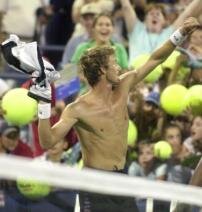 match Tuesday, 4-6, 7-5, 7-6(6), 6-7(4), 6-3 over Tomas Zib. Ferrero won the 3rd set converting seventh set point (he already led 5:4, 40/0 serving), having saved one in the process. In the 4th set the Spaniard led 3:0*, and was serving to win the match at 5:3. At one point in the 5th set both players were cramping. Zib was shaking his legs after every point, Ferrero was doing deep knee bends and each was leaving a puddle of sweat at his feet. A moment later, Zib was flinging his body in a full-length reach to drop a volley over the net and Ferrero was lunging and rolling to reach a crosscourt backhand. These matches seem to happen at the U.S. Open more often than at other Grand Slams because a day session can spill over to the night session. The mood changes as the sun leaves. “At the fifth set, the people were screaming a lot and very happy to watch the match,” Ferrero said. “I think they enjoy a lot and saw a very good match.” There were other five-setters Tuesday. Tim Henman, seeded fifth, had come up lame Saturday with a sore back. He will turn 30 next week. That is a tennis age when a sore back can mean the end of a career. So Henman played three sets as if he were afraid to bend over. His opponent, the 6-foot-10 Ivo Karlovic, didn’t bother to bend over. The tallest man on the pro circuit couldn’t unfurl himself enough to reach low balls or run fast enough to reach wide balls. So Karlovic served hard and hoped. He had 39 aces and it wasn’t until Henman loosened up in the heat that he found his game and won, 7-6(3), 6-7(7), 4-6, 6-4, 6-4. Rafael Nadal, 18, had been penciled into a second-round match against defending champion Andy Roddick, who advanced easily. He hit a 152-mph serve, fastest in U.S. Open history, and shrugged. His opponent was 17-year-old Scoville Jenkins from Atlanta, who qualified for the Open by winning the U.S. Tennis Assn. Boys Nationals in Kalamazoo last week. Jenkins was the first Afro-American winner of the tournament, which offers an automatic U.S. Open spot for the champion. The result Tuesday was as expected, a 6-0, 6-2, 6-2 win for Roddick and a standing ovation from the Arthur Ashe Stadium Court crowd when the teenager finally won a game. Nadal took much longer and suffered far more. It took him nearly three hours to subdue Switzerland’s
match Tuesday, 4-6, 7-5, 7-6(6), 6-7(4), 6-3 over Tomas Zib. Ferrero won the 3rd set converting seventh set point (he already led 5:4, 40/0 serving), having saved one in the process. In the 4th set the Spaniard led 3:0*, and was serving to win the match at 5:3. At one point in the 5th set both players were cramping. Zib was shaking his legs after every point, Ferrero was doing deep knee bends and each was leaving a puddle of sweat at his feet. A moment later, Zib was flinging his body in a full-length reach to drop a volley over the net and Ferrero was lunging and rolling to reach a crosscourt backhand. These matches seem to happen at the U.S. Open more often than at other Grand Slams because a day session can spill over to the night session. The mood changes as the sun leaves. “At the fifth set, the people were screaming a lot and very happy to watch the match,” Ferrero said. “I think they enjoy a lot and saw a very good match.” There were other five-setters Tuesday. Tim Henman, seeded fifth, had come up lame Saturday with a sore back. He will turn 30 next week. That is a tennis age when a sore back can mean the end of a career. So Henman played three sets as if he were afraid to bend over. His opponent, the 6-foot-10 Ivo Karlovic, didn’t bother to bend over. The tallest man on the pro circuit couldn’t unfurl himself enough to reach low balls or run fast enough to reach wide balls. So Karlovic served hard and hoped. He had 39 aces and it wasn’t until Henman loosened up in the heat that he found his game and won, 7-6(3), 6-7(7), 4-6, 6-4, 6-4. Rafael Nadal, 18, had been penciled into a second-round match against defending champion Andy Roddick, who advanced easily. He hit a 152-mph serve, fastest in U.S. Open history, and shrugged. His opponent was 17-year-old Scoville Jenkins from Atlanta, who qualified for the Open by winning the U.S. Tennis Assn. Boys Nationals in Kalamazoo last week. Jenkins was the first Afro-American winner of the tournament, which offers an automatic U.S. Open spot for the champion. The result Tuesday was as expected, a 6-0, 6-2, 6-2 win for Roddick and a standing ovation from the Arthur Ashe Stadium Court crowd when the teenager finally won a game. Nadal took much longer and suffered far more. It took him nearly three hours to subdue Switzerland’s 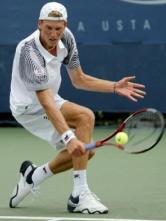 Ivo Heuberger, 6-0, 6-3, 4-6, 2-6, 6-3. Marat Safin, the 2000 Open winner seeded 13th this year, wished he could have played five sets. Supremely talented and uncommonly temperamental, Safin said after his 7-6(5), 6-4, 3-6, 6-3 loss to Thomas Enqvist that he lacked confidence. The first surprise of the day came as former semi-finalist and 14th seed Fernando Gonzalez of Chile went down to Sweden’s Robin Soderling 6-4, 7-6(3), 6-7(4), 6-1. And 20th seed Gustavo Kuerten followed Gonzalez out of the tournament, with former world junior champion Kristian Pless beating the Brazilian 6-4, 3-6, 6-1, 7-6(4). Basically that loss finished Kuerten’s career. The 28-year-old Brazilian didn’t play another match in that ’04 season. He’d been struggling with injuries in years 2005-08, playing rarely and poorly, before he decided to call time on tennis career at Roland Garros. 11th seeded Rainer Schuettler lost to a young Italian, Andreas Seppi 6-3, 6-4, 6-7(5), 6-7(1), 1-6. Schuettler led 6:5 (40/15) serving in the 3rd set; they met a month earlier in Kitzbuhel and it was Schuettler who had won saving match points – 10 in total!
Ivo Heuberger, 6-0, 6-3, 4-6, 2-6, 6-3. Marat Safin, the 2000 Open winner seeded 13th this year, wished he could have played five sets. Supremely talented and uncommonly temperamental, Safin said after his 7-6(5), 6-4, 3-6, 6-3 loss to Thomas Enqvist that he lacked confidence. The first surprise of the day came as former semi-finalist and 14th seed Fernando Gonzalez of Chile went down to Sweden’s Robin Soderling 6-4, 7-6(3), 6-7(4), 6-1. And 20th seed Gustavo Kuerten followed Gonzalez out of the tournament, with former world junior champion Kristian Pless beating the Brazilian 6-4, 3-6, 6-1, 7-6(4). Basically that loss finished Kuerten’s career. The 28-year-old Brazilian didn’t play another match in that ’04 season. He’d been struggling with injuries in years 2005-08, playing rarely and poorly, before he decided to call time on tennis career at Roland Garros. 11th seeded Rainer Schuettler lost to a young Italian, Andreas Seppi 6-3, 6-4, 6-7(5), 6-7(1), 1-6. Schuettler led 6:5 (40/15) serving in the 3rd set; they met a month earlier in Kitzbuhel and it was Schuettler who had won saving match points – 10 in total!
Second round: Diane Pucin
World number one Roger Federer battled past a spirited Marcos Baghdatis in Wednesday’s night match at the US Open. The Swiss star became the first man to reach the third round with a 6-2, 6-7(4), 6-3, 6-1 victory. Federer overwhelmed the 19-year-old Cypriot in the first set but let a lead slip in the second, before regaining his focus to wrap up the match. “I let him in the match and he took advantage of it,” said Federer after his victory. “He took his chances in the second set and surprised me with some of his shots.” On Court 11, packed with noisy Chilean and Armenian fans, 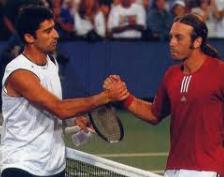 the 10th-seeded Nicolas Massu was upset by 31-year-old Sargis Sargsian, 6-7(6), 6-4, 3-6, 7-6(6), 6-4. It took 5 hours 9 minutes and at the end Massu bent over, exhausted and disgusted. Sargsian was serenaded by rooters who had chanted in Armenian all during the match. Only once, in a 1992 semifinal, had a match here gone longer when Stefan Edberg took 5:26 to beat Michael Chang 6-7, 7-5, 7-6, 5-7, 6-4. Massu broke rackets and carried on a 10-minute argument with chair umpire Carlos Ramos after being penalized a game in the 5th set for his third broken racket, one that was bounced so hard it caromed as high as his head. Massu’s rant to Ramos was profane. His tirade an hour after the match was angry. “I can’t believe I lost the match,” Massu said. “It’s hard to believe that this guy [Ramos] didn’t use the head a little bit. This guy come here, put to me two, three warnings. If I have to pay something I pay, no problem. But the third one? Unbelievable.” The first warning for equipment abuse had come to Massu at 4:4 in the 1st set after he wrecked a racket. Ramos gave Massu a point penalty in the 10th game of the 2nd set before taking away a game from him to start the 5th set when the angry Massu broke another racquet blowing a match point in the tie-break. In a statement, tournament referee Brian Earley explained why Massu was penalized a game. “There were three code violations for racket abuse,” Earley said. “Following the Grand Slam code of conduct, the first code violation resulted in a warning. The second violation resulted in a point penalty. The third violation resulted in a game penalty.” Three crushed rackets had been discarded by Massu, stark proof of his anger. The Olympic silver medalist didn’t have a good day either – Mardy Fish, seeded 26th, quarreled about line calls and hung his head after bad shots instead of fighting to hit better ones until he left a 6-3, 3-6, 1-6, 6-3, 6-3 loser to Czech
the 10th-seeded Nicolas Massu was upset by 31-year-old Sargis Sargsian, 6-7(6), 6-4, 3-6, 7-6(6), 6-4. It took 5 hours 9 minutes and at the end Massu bent over, exhausted and disgusted. Sargsian was serenaded by rooters who had chanted in Armenian all during the match. Only once, in a 1992 semifinal, had a match here gone longer when Stefan Edberg took 5:26 to beat Michael Chang 6-7, 7-5, 7-6, 5-7, 6-4. Massu broke rackets and carried on a 10-minute argument with chair umpire Carlos Ramos after being penalized a game in the 5th set for his third broken racket, one that was bounced so hard it caromed as high as his head. Massu’s rant to Ramos was profane. His tirade an hour after the match was angry. “I can’t believe I lost the match,” Massu said. “It’s hard to believe that this guy [Ramos] didn’t use the head a little bit. This guy come here, put to me two, three warnings. If I have to pay something I pay, no problem. But the third one? Unbelievable.” The first warning for equipment abuse had come to Massu at 4:4 in the 1st set after he wrecked a racket. Ramos gave Massu a point penalty in the 10th game of the 2nd set before taking away a game from him to start the 5th set when the angry Massu broke another racquet blowing a match point in the tie-break. In a statement, tournament referee Brian Earley explained why Massu was penalized a game. “There were three code violations for racket abuse,” Earley said. “Following the Grand Slam code of conduct, the first code violation resulted in a warning. The second violation resulted in a point penalty. The third violation resulted in a game penalty.” Three crushed rackets had been discarded by Massu, stark proof of his anger. The Olympic silver medalist didn’t have a good day either – Mardy Fish, seeded 26th, quarreled about line calls and hung his head after bad shots instead of fighting to hit better ones until he left a 6-3, 3-6, 1-6, 6-3, 6-3 loser to Czech 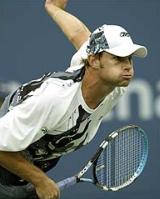 qualifier Michal Tabara. It was a good day to be Andre Agassi. Just when it looked as if the oldest man in the draw was struggling, his 20-year-old German opponent, Florian Mayer, pulled a hamstring and had to retire, handing Agassi a 7-5, 2-6, 6-2, 1-0 win. Then Mayer grumbled. “If I had no injury,” he said, “I think I had good chances to beat him.” Andy Roddick produced a stunning display of raw power to crush Rafael Nadal 6-0, 6-3, 6-4. The match was expected to be one of the highlights of the first week but 18-year-old Nadal was simply overwhelmed. The American fired down a 152 mph serve in his opening service game and dropped just nine points in the 1st set. Nadal regained some pride in a tight 3rd set and went a break up before Roddick levelled at 4:4 and broke the Spaniard again to seal victory. “I felt like I played really well for the first two sets,” Roddick said. “I kind of had a concentration lapse at the start of the third set but I was able to come through in the end.” Fourth seed Lleyton Hewitt gave another display of his title credentials with a 7-6(7), 6-1, 6-2 win over Morocco’s Hicham Arazi. The Australian said he was grateful to come through a potentially tricky match in straight sets. “It’s always good to get the first set, especially against a guy who’s flashy and capable of some great shots,” Hewitt said. He staved off two set points in the tie-break. Elsewhere, eighth seed David Nalbandian made a surprise second-round exit to Mikhail Youzhny. Nalbandian, who lost in the semi-finals last year, was beaten 7-6(4), 4-6, 5-7, 6-2, 4-6 by the Russian in 3 hours 58 minutes. Each player won
qualifier Michal Tabara. It was a good day to be Andre Agassi. Just when it looked as if the oldest man in the draw was struggling, his 20-year-old German opponent, Florian Mayer, pulled a hamstring and had to retire, handing Agassi a 7-5, 2-6, 6-2, 1-0 win. Then Mayer grumbled. “If I had no injury,” he said, “I think I had good chances to beat him.” Andy Roddick produced a stunning display of raw power to crush Rafael Nadal 6-0, 6-3, 6-4. The match was expected to be one of the highlights of the first week but 18-year-old Nadal was simply overwhelmed. The American fired down a 152 mph serve in his opening service game and dropped just nine points in the 1st set. Nadal regained some pride in a tight 3rd set and went a break up before Roddick levelled at 4:4 and broke the Spaniard again to seal victory. “I felt like I played really well for the first two sets,” Roddick said. “I kind of had a concentration lapse at the start of the third set but I was able to come through in the end.” Fourth seed Lleyton Hewitt gave another display of his title credentials with a 7-6(7), 6-1, 6-2 win over Morocco’s Hicham Arazi. The Australian said he was grateful to come through a potentially tricky match in straight sets. “It’s always good to get the first set, especially against a guy who’s flashy and capable of some great shots,” Hewitt said. He staved off two set points in the tie-break. Elsewhere, eighth seed David Nalbandian made a surprise second-round exit to Mikhail Youzhny. Nalbandian, who lost in the semi-finals last year, was beaten 7-6(4), 4-6, 5-7, 6-2, 4-6 by the Russian in 3 hours 58 minutes. Each player won 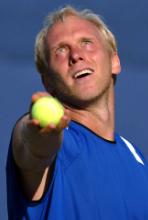 168 points. Nalbandian has been dogged by injury all year and was playing only his second tournament since May. Former world number two Tommy Haas booked his place in the third round with a 6-4, 6-4, 1-6, 6-1 win over 12th seed Sebastien Grosjean. The German is rediscovering his best form following a 15-month absence with a shoulder injury. Juan Carlos Ferrero‘s miserable season continued when he was beaten in the US Open second round by Stefan Koubek. Koubek upset the 2003 runner-up 7-6(2), 4-6, 6-7(6), 6-2, 6-3 in a 4-hour battle. Ferrero, who has struggled with his fitness for most of the season, had treatment for a leg injury straight after winning the 3rd set. Koubek seized his chance to level the match and though Ferrero had a 2:0* lead in the decider, Koubek won five games in a row before clinching the win. “I was fighting a lot and I won the second and third set but then I started to feel a pain in my leg,” said Ferrero. “I couldn’t serve and move very well because of my leg. It’s frustrating. Of course, I’m not so happy this year. This year will finish soon, and I want to forget this year.”
168 points. Nalbandian has been dogged by injury all year and was playing only his second tournament since May. Former world number two Tommy Haas booked his place in the third round with a 6-4, 6-4, 1-6, 6-1 win over 12th seed Sebastien Grosjean. The German is rediscovering his best form following a 15-month absence with a shoulder injury. Juan Carlos Ferrero‘s miserable season continued when he was beaten in the US Open second round by Stefan Koubek. Koubek upset the 2003 runner-up 7-6(2), 4-6, 6-7(6), 6-2, 6-3 in a 4-hour battle. Ferrero, who has struggled with his fitness for most of the season, had treatment for a leg injury straight after winning the 3rd set. Koubek seized his chance to level the match and though Ferrero had a 2:0* lead in the decider, Koubek won five games in a row before clinching the win. “I was fighting a lot and I won the second and third set but then I started to feel a pain in my leg,” said Ferrero. “I couldn’t serve and move very well because of my leg. It’s frustrating. Of course, I’m not so happy this year. This year will finish soon, and I want to forget this year.”
Third round: (CNN)
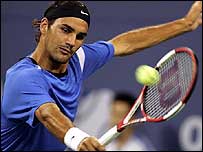 World number one and top seed Roger Federer stayed on course for his third Grand Slam title of the year with a straight sets victory over Fabrice Santoro of France in the U.S. Open at Flushing Meadows on Saturday. The stylish Swiss won the third round match 6-0, 6-4, 7-6(7) in a little over two hours, only facing serious resistance from the 31st-seeded Frenchman in the third set. Santoro breathed a sigh of relief when finally getting on the scoreboard, but a single break was enough to secure his opponent a two sets to love lead. The 3rd set was a closer affair, lasting nearly an hour, but Federer kept his nerve to win the tie-break as Santoro volleyed wide following an epic point. But the top-seed was pleased to escape with the win: “I had a great first set, I barely made a mistake, but he started to play better. He has a great first serve and can really move the ball. We had some great rallies, it was some good tennis out there, we had fun.” Sargis Sargsian, a 31-year-old Armenian, almost certainly will not win this US Open. But he has won hearts and whenever he leaves here, will know that no one has played harder or earned more genuine affection from the fans who have watched him. On Saturday night, Sargsian collapsed to the ground and rolled his knees to his chest. After 4 hours 44 minutes, he had beaten Frenchman Paul-Henri Mathieu, 4-6, 4-6, 6-4, 6-2, 7-6(4) after saving two match points. Sargsian became the first man since Brad Gilbert in 1992 to win two consecutive US Open matches facing match points. Two nights earlier, on another cosy place, court 11, Sargsian had upset 10th seed and Olympic gold medalist Nicolas Massu of Chile in a match that lasted 5 hours 9 minutes, the second longest at the Open. According to historians, Sargsian has played in the longest successive matches at the Open. “You’re in a different world when you win these matches,” Sargsian said. “Like right now, I’m talking, I feel like it’s not me talking, it’s just words don’t come out. It’s a weird feeling.” Andre Agassi became a 6-4, 6-2, 6-3 winner over No. 25 Jiri Novak while No. 5 Tim Henman outlasted
World number one and top seed Roger Federer stayed on course for his third Grand Slam title of the year with a straight sets victory over Fabrice Santoro of France in the U.S. Open at Flushing Meadows on Saturday. The stylish Swiss won the third round match 6-0, 6-4, 7-6(7) in a little over two hours, only facing serious resistance from the 31st-seeded Frenchman in the third set. Santoro breathed a sigh of relief when finally getting on the scoreboard, but a single break was enough to secure his opponent a two sets to love lead. The 3rd set was a closer affair, lasting nearly an hour, but Federer kept his nerve to win the tie-break as Santoro volleyed wide following an epic point. But the top-seed was pleased to escape with the win: “I had a great first set, I barely made a mistake, but he started to play better. He has a great first serve and can really move the ball. We had some great rallies, it was some good tennis out there, we had fun.” Sargis Sargsian, a 31-year-old Armenian, almost certainly will not win this US Open. But he has won hearts and whenever he leaves here, will know that no one has played harder or earned more genuine affection from the fans who have watched him. On Saturday night, Sargsian collapsed to the ground and rolled his knees to his chest. After 4 hours 44 minutes, he had beaten Frenchman Paul-Henri Mathieu, 4-6, 4-6, 6-4, 6-2, 7-6(4) after saving two match points. Sargsian became the first man since Brad Gilbert in 1992 to win two consecutive US Open matches facing match points. Two nights earlier, on another cosy place, court 11, Sargsian had upset 10th seed and Olympic gold medalist Nicolas Massu of Chile in a match that lasted 5 hours 9 minutes, the second longest at the Open. According to historians, Sargsian has played in the longest successive matches at the Open. “You’re in a different world when you win these matches,” Sargsian said. “Like right now, I’m talking, I feel like it’s not me talking, it’s just words don’t come out. It’s a weird feeling.” Andre Agassi became a 6-4, 6-2, 6-3 winner over No. 25 Jiri Novak while No. 5 Tim Henman outlasted 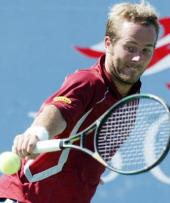 other Czech player, qualifier Michal Tabara 4-6, 6-3, 5-7, 6-4, 6-3 establishing quickly a save lead in the last two sets. The Briton admitted his back problem was still a cause for concern. “My energy levels were fine but towards the end, during the changeovers, my back was getting quite stiff,” he said. Third seed Carlos Moya double faulted on match point as he was upset by Belgium’s Olivier Rochus 4-6, 6-4, 6-3, 6-7(5), 7-5. Moya, who was playing with his highest Grand Slam seeding ever, suffered his first loss to the unseeded Rochus in three career matches. The 1998 French Open champ Moya had 10 aces but he couldn’t overcome eight double faults, including one in the 5th that clinched the victory for Rochus. Moya also had more unforced errors (61-36) in the 3 hour, 38 minute match. Rochus moves on to the fourth round where he will face Slovakia’s Dominik Hrbaty who defeated 15th seed Paradorn Srichaphan 7-6(8), 6-3, 6-3. Rochus hit 46 winners and converted 8 of 15 break point chances to win his third straight match after going winless in his four previous US Open appearances. Defending champion Andy Roddick maintained his blistering form at the US Open with a 6-1, 6-3, 6-3 win over Argentina’s Guillermo Canas. The second seed faced two break points in the opening game of the match, but having saved those he was never in trouble again. Canas won a total of just 17 points on the American’s serve and was broken five times. The American refused to get carried away by his stunning performance against Canas, in which he served 21 aces, no double faults and saved all five break points he faced. “I had a game plan, I executed it. I took it to him,” said the 22-
other Czech player, qualifier Michal Tabara 4-6, 6-3, 5-7, 6-4, 6-3 establishing quickly a save lead in the last two sets. The Briton admitted his back problem was still a cause for concern. “My energy levels were fine but towards the end, during the changeovers, my back was getting quite stiff,” he said. Third seed Carlos Moya double faulted on match point as he was upset by Belgium’s Olivier Rochus 4-6, 6-4, 6-3, 6-7(5), 7-5. Moya, who was playing with his highest Grand Slam seeding ever, suffered his first loss to the unseeded Rochus in three career matches. The 1998 French Open champ Moya had 10 aces but he couldn’t overcome eight double faults, including one in the 5th that clinched the victory for Rochus. Moya also had more unforced errors (61-36) in the 3 hour, 38 minute match. Rochus moves on to the fourth round where he will face Slovakia’s Dominik Hrbaty who defeated 15th seed Paradorn Srichaphan 7-6(8), 6-3, 6-3. Rochus hit 46 winners and converted 8 of 15 break point chances to win his third straight match after going winless in his four previous US Open appearances. Defending champion Andy Roddick maintained his blistering form at the US Open with a 6-1, 6-3, 6-3 win over Argentina’s Guillermo Canas. The second seed faced two break points in the opening game of the match, but having saved those he was never in trouble again. Canas won a total of just 17 points on the American’s serve and was broken five times. The American refused to get carried away by his stunning performance against Canas, in which he served 21 aces, no double faults and saved all five break points he faced. “I had a game plan, I executed it. I took it to him,” said the 22-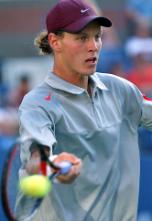 year-old, who is yet to drop a set and has lost his serve just once. “I really don’t have a magical explanation for it.” Lleyton Hewitt, another contender for the title, reached the fourth round with a 6-1, 6-4, 6-2 win over Feliciano Lopez. Tommy Haas took his US Open record to 16-7 with a routine 6-2, 6-3, 7-5 win over Ricardo Mello in the third round. The 26-year-old, in the last 16 for the fourth time in his career, will face Tomas Berdych, who outlasted Mikhail Youzhny 2-6, 6-1, 6-3, 4-6, 6-1. Berdych, playing his 13th main-level tournament, had also won his opening match in a lopsided 5-setter as he eliminated Jonas Bjorkman 6-3 in the 5th set. Talented Swede Joachim Johansson was an early winner on day seven of the tournament, beating Austria’s Stefan Koubek 6-7(2), 7-6(1), 6-1, 6-3. Johansson served 19 aces and wasn’t broken (faced five break points).
year-old, who is yet to drop a set and has lost his serve just once. “I really don’t have a magical explanation for it.” Lleyton Hewitt, another contender for the title, reached the fourth round with a 6-1, 6-4, 6-2 win over Feliciano Lopez. Tommy Haas took his US Open record to 16-7 with a routine 6-2, 6-3, 7-5 win over Ricardo Mello in the third round. The 26-year-old, in the last 16 for the fourth time in his career, will face Tomas Berdych, who outlasted Mikhail Youzhny 2-6, 6-1, 6-3, 4-6, 6-1. Berdych, playing his 13th main-level tournament, had also won his opening match in a lopsided 5-setter as he eliminated Jonas Bjorkman 6-3 in the 5th set. Talented Swede Joachim Johansson was an early winner on day seven of the tournament, beating Austria’s Stefan Koubek 6-7(2), 7-6(1), 6-1, 6-3. Johansson served 19 aces and wasn’t broken (faced five break points).
Fourth round: (CNN)
Former champion Andre Agassi produced a devastating display to sweep aside Armenia’s Sargis Sargsian 6-3, 6-2, 6-2 and reach the last eight of the US Open. The 34-year-old American set the pace of the match, quickly opening up a 2:0 lead in the 1st set which he took before racing to the second. There was no way back for Sargsian, who received treatment on a knee injury, as Agassi rattled off the third set as easily as the two previous sets. He now faces Swiss Roger Federer in a hotly-anticipated quarter-final. The world number one had a walkover into the last eight after his fourth round opponent Andrei Pavel withdrew with a back injury. The Romanian has been beset by wrist and back problems since last April and did not want to aggravate his injuries further in New York. “I never 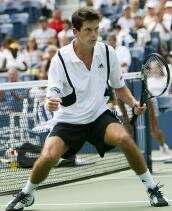 expect to win easily,” Agassi insisted. “Sarg hasn’t won three matches for no reason, I just wanted to take care of business.” Tim Henman reached the US Open quarter-finals for the first time after German Nicolas Kiefer retired with injury. Henman battled back from a poor start and had victory in his sights with the match poised at 6-7(5), 6-3, 6-1, 6-7(4), 3-0 before Kiefer damaged a tendon. The German complained he felt no power in his right wrist after a serve. “It’s a strange way to win a match after I’d been fighting so hard,” admitted Henman. “Kiefer told me he felt something pop in his wrist and it was a tough break for him.” The German 27-year-old will now have further tests to determine the extent of his injury. “I hit a reflex volley and when I tried to hit a big serve on the next point I couldn’t hold the racket,” said Kiefer. “It was a tough decision because I wanted to finish the match.” Henman despite recovering to break Kiefer twice and saving a set-point, could not prevent the in-form German wrapping up the first tie-break. Kiefer looked to be in control as he grabbed a break to go 3:1 up in the 2nd set. But a dogged Henman notched up 10 straight games to take the next two sets with ease. The 4th set was an intense encounter and Kiefer let his anger get the better of him as he bitterly disputed a foot-fault and a line-call. However, the German was able to keep a cool head to edge the tie-break with some searing backhands and force a 5th set. Dominik Hrbaty will meet Henman in the last eight after he overcame Olivier Rochus in an engrossing encounter. The Slovakian 22nd seed came back from two sets down to see off the Belgian 2-6, 3-6, 6-3, 6-4, 6-0. Rochus looked to be on course for a place in the last eight but his game came unstuck when he picked up an injury. He had won his two previous matches in five sets, and led 4:1* in the
expect to win easily,” Agassi insisted. “Sarg hasn’t won three matches for no reason, I just wanted to take care of business.” Tim Henman reached the US Open quarter-finals for the first time after German Nicolas Kiefer retired with injury. Henman battled back from a poor start and had victory in his sights with the match poised at 6-7(5), 6-3, 6-1, 6-7(4), 3-0 before Kiefer damaged a tendon. The German complained he felt no power in his right wrist after a serve. “It’s a strange way to win a match after I’d been fighting so hard,” admitted Henman. “Kiefer told me he felt something pop in his wrist and it was a tough break for him.” The German 27-year-old will now have further tests to determine the extent of his injury. “I hit a reflex volley and when I tried to hit a big serve on the next point I couldn’t hold the racket,” said Kiefer. “It was a tough decision because I wanted to finish the match.” Henman despite recovering to break Kiefer twice and saving a set-point, could not prevent the in-form German wrapping up the first tie-break. Kiefer looked to be in control as he grabbed a break to go 3:1 up in the 2nd set. But a dogged Henman notched up 10 straight games to take the next two sets with ease. The 4th set was an intense encounter and Kiefer let his anger get the better of him as he bitterly disputed a foot-fault and a line-call. However, the German was able to keep a cool head to edge the tie-break with some searing backhands and force a 5th set. Dominik Hrbaty will meet Henman in the last eight after he overcame Olivier Rochus in an engrossing encounter. The Slovakian 22nd seed came back from two sets down to see off the Belgian 2-6, 3-6, 6-3, 6-4, 6-0. Rochus looked to be on course for a place in the last eight but his game came unstuck when he picked up an injury. He had won his two previous matches in five sets, and led 4:1* in the  4th set. He bagan suffering cramps in the 5th game of that set, afterwards couldn’t win another game losing 11 in a row. Former champion Lleyton Hewitt reached his third consecutive Grand Slam quarterfinal Tuesday, defeating Karol Beck 6-4, 6-2, 6-2, at the U.S. Open for his 14th consecutive match victory. American Andy Roddick has yet to be challenged in his title defense as he beat No. 18 Tommy Robredo of Spain 6-3, 6-2, 6-4 Tuesday night to move into the quarterfinals without having lost a set. Roddick saved both break points he faced against Robredo, and he’s been broken only once through 50 service games over his four matches. “I played solid. I’m serving well. I’m breaking well,” said Roddick, who had 11 aces to raise his tournament total to 53. Roddick’s next opponent is the leader in that category: No. 28 Joachim Johansson, who has 79 aces after beating Michael Llodra 6-2, 6-3, 6-2. Tomas Berdych squandered a set point on serve in a 1st set tie-break against Tommy Haas, and lost 6-7(6), 1-6, 5-7.
4th set. He bagan suffering cramps in the 5th game of that set, afterwards couldn’t win another game losing 11 in a row. Former champion Lleyton Hewitt reached his third consecutive Grand Slam quarterfinal Tuesday, defeating Karol Beck 6-4, 6-2, 6-2, at the U.S. Open for his 14th consecutive match victory. American Andy Roddick has yet to be challenged in his title defense as he beat No. 18 Tommy Robredo of Spain 6-3, 6-2, 6-4 Tuesday night to move into the quarterfinals without having lost a set. Roddick saved both break points he faced against Robredo, and he’s been broken only once through 50 service games over his four matches. “I played solid. I’m serving well. I’m breaking well,” said Roddick, who had 11 aces to raise his tournament total to 53. Roddick’s next opponent is the leader in that category: No. 28 Joachim Johansson, who has 79 aces after beating Michael Llodra 6-2, 6-3, 6-2. Tomas Berdych squandered a set point on serve in a 1st set tie-break against Tommy Haas, and lost 6-7(6), 1-6, 5-7.
Quarterfinals: Charles Bricker
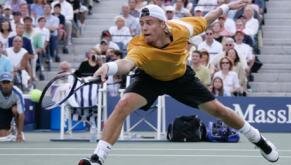 A mechanical Lleyton Hewitt drove Tommy Haas stir crazy to reach his fourth US Open semi-final in five years with a commanding straight-sets victory over the German. Defying terrible playing conditions on a blustery day in New York, Hewitt produced some impeccable tennis to blitz Haas 6-2, 6-2, 6-2 in his most impressive performance of the tournament. Hewitt, 23, has now won 15 straight matches and is still to lose a set this campaign. “That was some of the toughest conditions I’ve ever played in,” said Hewitt. Over the course of two days and four sets Tim Henman overcame Dominik Hrbaty, the tail end of hurricane Frances and his own pre-tournament misgivings to reach a US Open semi-final with a 6-1, 7-5, 5-7, 6-2 victory. Yesterday the rain had at least held off but the wind was strong and swirling. And, just 15 hours after he had been within touching distance of beating Hrbaty on Wednesday night – he was two sets to the good and serving at 4:5 – he looked stiff and sore as he came back to try to finish off the Slovakian. Briefly Hrbaty sniffed a chance. He tried to beat Henman at his own game, chipping and charging and trying to knock Henman off balance. It worked just long enough to snatch the 3rd set but after that Henman took control. Wincing slightly, he started to bully Hrbaty from the net. He came forward swiftly and with menacing intent, claiming the first break of serve in the opening game. He started to find his spots with the
A mechanical Lleyton Hewitt drove Tommy Haas stir crazy to reach his fourth US Open semi-final in five years with a commanding straight-sets victory over the German. Defying terrible playing conditions on a blustery day in New York, Hewitt produced some impeccable tennis to blitz Haas 6-2, 6-2, 6-2 in his most impressive performance of the tournament. Hewitt, 23, has now won 15 straight matches and is still to lose a set this campaign. “That was some of the toughest conditions I’ve ever played in,” said Hewitt. Over the course of two days and four sets Tim Henman overcame Dominik Hrbaty, the tail end of hurricane Frances and his own pre-tournament misgivings to reach a US Open semi-final with a 6-1, 7-5, 5-7, 6-2 victory. Yesterday the rain had at least held off but the wind was strong and swirling. And, just 15 hours after he had been within touching distance of beating Hrbaty on Wednesday night – he was two sets to the good and serving at 4:5 – he looked stiff and sore as he came back to try to finish off the Slovakian. Briefly Hrbaty sniffed a chance. He tried to beat Henman at his own game, chipping and charging and trying to knock Henman off balance. It worked just long enough to snatch the 3rd set but after that Henman took control. Wincing slightly, he started to bully Hrbaty from the net. He came forward swiftly and with menacing intent, claiming the first break of serve in the opening game. He started to find his spots with the 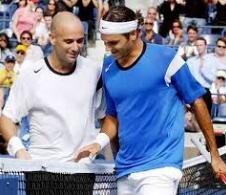 serve and construct the points with care and clarity. He did not give Hrbaty an inch throughout the 4th set and once he had broken again for a 4:1 lead, he was cruising towards the semi-finals. Roger Federer battled past Andre Agassi in five sets. The Swiss resumed leading by two sets to one after rain stopped play on Wednesday, but Agassi leveled with the only break in a tight 4th set. The pressure was now on Federer and, in windy conditions, he claimed the decisive break in game eight for a 6-3, 2-6, 7-5, 3-6, 6-3 victory. Federer will meet Henman on Saturday for a place in the final. The top seed missed two chances to take control of the match as he let break points slip by in the fourth set and Agassi eventually made him pay as he leveled the match. But it was the Australian Open and Wimbledon champion who looked the more composed in the final set as the wind became increasingly difficult. “I was a little worried,” Federer admitted afterwards. “I missed chances in the fourth when I had a couple of break points and from then on it was 50-50, who’s going to make the mistakes, and he did at the right time for me.” Then, with the weather finally settling down in the evening and Andy Roddick‘s ire firing up over a couple of line calls, the defending champion was swept aside, despite hitting 34 aces, by young Swede Joachim Johansson 6-4, 6-4, 3-6, 2-6, 6-4. Roddick seemed on his way to a third career comeback from two sets down when Johansson, who had never before been in a five-setter, stabilized and broke in the final game for the win. Roddick was down love-40 trying to survive at 4:5 and got two points back. But, surprisingly, a backhand off his racket sailed well over the baseline at 30/40 and it was over. Roddick started poorly while Johansson hit a succession of spectacular shots, most of
serve and construct the points with care and clarity. He did not give Hrbaty an inch throughout the 4th set and once he had broken again for a 4:1 lead, he was cruising towards the semi-finals. Roger Federer battled past Andre Agassi in five sets. The Swiss resumed leading by two sets to one after rain stopped play on Wednesday, but Agassi leveled with the only break in a tight 4th set. The pressure was now on Federer and, in windy conditions, he claimed the decisive break in game eight for a 6-3, 2-6, 7-5, 3-6, 6-3 victory. Federer will meet Henman on Saturday for a place in the final. The top seed missed two chances to take control of the match as he let break points slip by in the fourth set and Agassi eventually made him pay as he leveled the match. But it was the Australian Open and Wimbledon champion who looked the more composed in the final set as the wind became increasingly difficult. “I was a little worried,” Federer admitted afterwards. “I missed chances in the fourth when I had a couple of break points and from then on it was 50-50, who’s going to make the mistakes, and he did at the right time for me.” Then, with the weather finally settling down in the evening and Andy Roddick‘s ire firing up over a couple of line calls, the defending champion was swept aside, despite hitting 34 aces, by young Swede Joachim Johansson 6-4, 6-4, 3-6, 2-6, 6-4. Roddick seemed on his way to a third career comeback from two sets down when Johansson, who had never before been in a five-setter, stabilized and broke in the final game for the win. Roddick was down love-40 trying to survive at 4:5 and got two points back. But, surprisingly, a backhand off his racket sailed well over the baseline at 30/40 and it was over. Roddick started poorly while Johansson hit a succession of spectacular shots, most of 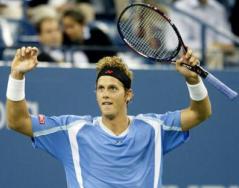 them inside-out forehands. He had 15 of his 30 aces in the first two sets, and converted the only two break points Roddick gave him. But Roddick became more aggressive in the third and fourth sets as Johansson seemed to cool and play more conservatively. By the end of the fourth set, the momentum was solidly in Roddick’s corner. Roddick had two break-point opportunities in the final set and couldn’t convert. In fact, he converted only 3 of 15 break-point opportunities in the match. After the match, Roddick was spotted running laps around the inside hallway of the stadium. “I’ll recover, I’ll be fine,” Roddick said. “If I felt great, something would be wrong. I don’t feel good about this but at the same time I fought to the end and gave it everything I had.” Roddick finishes his Grand Slam tour with a quarterfinal finish at Australia, second round at the French, runner-up at Wimbledon and quarterfinal here. He said his defeats at the last two Slams “will make me hungrier.” Roddick beat Johansson at an indoor tournament in San Jose. “Today I stepped back at bit and got a few more returns,” Johansson said.
them inside-out forehands. He had 15 of his 30 aces in the first two sets, and converted the only two break points Roddick gave him. But Roddick became more aggressive in the third and fourth sets as Johansson seemed to cool and play more conservatively. By the end of the fourth set, the momentum was solidly in Roddick’s corner. Roddick had two break-point opportunities in the final set and couldn’t convert. In fact, he converted only 3 of 15 break-point opportunities in the match. After the match, Roddick was spotted running laps around the inside hallway of the stadium. “I’ll recover, I’ll be fine,” Roddick said. “If I felt great, something would be wrong. I don’t feel good about this but at the same time I fought to the end and gave it everything I had.” Roddick finishes his Grand Slam tour with a quarterfinal finish at Australia, second round at the French, runner-up at Wimbledon and quarterfinal here. He said his defeats at the last two Slams “will make me hungrier.” Roddick beat Johansson at an indoor tournament in San Jose. “Today I stepped back at bit and got a few more returns,” Johansson said.
Semifinals: Howard Fendrich
Top-ranked Roger Federer moved within a victory of becoming the first man since 1988 to win three Grand Slam tournaments in a year, beating No. 5 Tim Henman 6-3, 6-4, 6-4 Saturday in the U.S. Open semifinals. “I feel very confident out on the court,” Federer said. “It’s important that every day, I 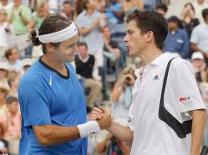 wake up, I’m 100% into tennis and ready to go.” In Sunday’s final, Federer will play 2001 Open champion Lleyton Hewitt, who was nearly flawless himself in eliminating No. 28 Joachim Johansson 6-4, 7-5, 6-3. As Hewitt scrambled along the baseline, getting to everything Johansson offered, his sneakers squeaked with each step, sounding like high-pitched bird chirps. It was the first time since 1986 that no Americans were in the men’s semifinals at the U.S. Open. Only three players have more than five career wins over Federer, and two are Henman (now 6-3 against the Swiss star) and Hewitt (8-5). Asked what weaknesses of Federer’s he’ll try to exploit, Hewitt said: “I don’t know. There’s not a lot of them.” The crowds at the Open love an underdog, and Henman got more positive energy Saturday than he normally does at Wimbledon, where he’s hounded by the pressure of a nation looking for a British champion. The fans tried to will him past Federer, who silenced them by conjuring twice as many winners (31) as unforced errors (15). Federer might not hit serves at 150 mph the way Andy Roddick does but he knows where to place them and how to vary them. He befuddled Henman at the start, winning 12 straight points on serve only twice in that span did Henman manage to put the ball in play. Overall, Federer showed off perfectly cut drop shots, stinging passes, volleys, aces, return winners: “You name it, he did it. who hits the ball like that,” said Henman, 0-6 in major semifinals. “If you take Roddick’s serve and Agassi’s returns and my volleys and Hewitt’s speed and tenacity, then you’ve probably got a good chance against Federer.” Case in point: the 8th game of the match, after the players traded breaks. With Henman serving, Federer displayed unbelievable variety. He flicked a forehand lob that curled over Henman and landed right where the baseline and sideline meet, similar to a momentum-shifting lob he cut through 40 mph wind against Agassi in the quarterfinals. Then Federer raced to the net behind a deep approach shot, drawing a forehand error from a rushed Henman. Federer sealed the break with a forehand passing winner. “I surprised myself today, what shots I pulled off, because some were at very important moments, and these are the ones that count the most,” said Federer, 63-6 in 2004 with a tour-leading eight titles, including the Australian Open and Wimbledon. Hewitt, the 2002 Wimbledon champ, owns a 16-match winning streak. But he lost to the eventual champion at the other three majors this year, including to Federer in Australia and
wake up, I’m 100% into tennis and ready to go.” In Sunday’s final, Federer will play 2001 Open champion Lleyton Hewitt, who was nearly flawless himself in eliminating No. 28 Joachim Johansson 6-4, 7-5, 6-3. As Hewitt scrambled along the baseline, getting to everything Johansson offered, his sneakers squeaked with each step, sounding like high-pitched bird chirps. It was the first time since 1986 that no Americans were in the men’s semifinals at the U.S. Open. Only three players have more than five career wins over Federer, and two are Henman (now 6-3 against the Swiss star) and Hewitt (8-5). Asked what weaknesses of Federer’s he’ll try to exploit, Hewitt said: “I don’t know. There’s not a lot of them.” The crowds at the Open love an underdog, and Henman got more positive energy Saturday than he normally does at Wimbledon, where he’s hounded by the pressure of a nation looking for a British champion. The fans tried to will him past Federer, who silenced them by conjuring twice as many winners (31) as unforced errors (15). Federer might not hit serves at 150 mph the way Andy Roddick does but he knows where to place them and how to vary them. He befuddled Henman at the start, winning 12 straight points on serve only twice in that span did Henman manage to put the ball in play. Overall, Federer showed off perfectly cut drop shots, stinging passes, volleys, aces, return winners: “You name it, he did it. who hits the ball like that,” said Henman, 0-6 in major semifinals. “If you take Roddick’s serve and Agassi’s returns and my volleys and Hewitt’s speed and tenacity, then you’ve probably got a good chance against Federer.” Case in point: the 8th game of the match, after the players traded breaks. With Henman serving, Federer displayed unbelievable variety. He flicked a forehand lob that curled over Henman and landed right where the baseline and sideline meet, similar to a momentum-shifting lob he cut through 40 mph wind against Agassi in the quarterfinals. Then Federer raced to the net behind a deep approach shot, drawing a forehand error from a rushed Henman. Federer sealed the break with a forehand passing winner. “I surprised myself today, what shots I pulled off, because some were at very important moments, and these are the ones that count the most,” said Federer, 63-6 in 2004 with a tour-leading eight titles, including the Australian Open and Wimbledon. Hewitt, the 2002 Wimbledon champ, owns a 16-match winning streak. But he lost to the eventual champion at the other three majors this year, including to Federer in Australia and 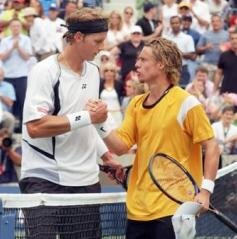 England. “Playing Roger, I’m going to have to play some great tennis,” Hewitt said. “But I feel like I’m playing well at the moment, and I give myself a good chance.” He stared down the 6-foot-6 Johansson’s booming serves and forehands, the same ones that were too much for defending champion Roddick. Hewitt broke Johansson in the final game of each of the first two sets and in the next-to-last game of No. 3. Hewitt faced just one break point, which he saved, and finished with a flourish, claiming the last 12 points. He hasn’t lost a set; no man won the Open without dropping a set since Neale Fraser in 1960. “If he’s playing like this,” Johansson said, “it’s going to be tough for the other guy.” No. 4 Hewitt and No. 28 Johansson never had played for real, at any level, but they know each other well. Johansson’s girlfriend is Hewitt’s sister, Jaslyn not wanting to take sides, she sat in a private suite instead of either player’s guest box. During offseasons, Hewitt and Johansson practice together on the court in the Hewitt family home’s back yard in Adelaide. All in all, was it awkward Saturday? “I’m not sure how he felt,” Johansson said, “but it seemed like he felt fine.”
England. “Playing Roger, I’m going to have to play some great tennis,” Hewitt said. “But I feel like I’m playing well at the moment, and I give myself a good chance.” He stared down the 6-foot-6 Johansson’s booming serves and forehands, the same ones that were too much for defending champion Roddick. Hewitt broke Johansson in the final game of each of the first two sets and in the next-to-last game of No. 3. Hewitt faced just one break point, which he saved, and finished with a flourish, claiming the last 12 points. He hasn’t lost a set; no man won the Open without dropping a set since Neale Fraser in 1960. “If he’s playing like this,” Johansson said, “it’s going to be tough for the other guy.” No. 4 Hewitt and No. 28 Johansson never had played for real, at any level, but they know each other well. Johansson’s girlfriend is Hewitt’s sister, Jaslyn not wanting to take sides, she sat in a private suite instead of either player’s guest box. During offseasons, Hewitt and Johansson practice together on the court in the Hewitt family home’s back yard in Adelaide. All in all, was it awkward Saturday? “I’m not sure how he felt,” Johansson said, “but it seemed like he felt fine.”
Final: Stephen Birley
Roger Federer became the first man since Sweden’s Mats Wilander in 1988 to win three Grand Slam titles in a calendar year when he beat Australia’s Lleyton Hewitt 6-0, 7-6(3), 6-0 in their US Open day-night final here yesterday. Earlier this year Federer won the Australian Open and the Wimbledon crown and by beating Hewitt the Swiss world No. 1 became the first male player in the  Open era to win his opening four Grand Slam finals, including last year’s Wimbledon. The primeval roar of triumph when he defeated Andre Agassi over five sets in the quarter-finals signaled it as Federer’s most critical victory over the last fortnight. He easily defeated Tim Henman in Saturday’s semi-final and he put the skids under Hewitt after an epic second set. Hewitt had led Federer 8-5 coming into the final, the most extraordinary of these victories coming in the Davis Cup semi-final last year in Melbourne when Hewitt was two sets down before famously winning in five sets. Since that defeat Federer has held the upper hand, winning their previous three matches before yesterday’s final, including a fourth-round win in the Australian Open on the same Rod Laver centre court and again in the fourth round of Wimbledon. “There is no more fear but I respect him as a great player and a great competitor,” said Federer. The one thing he did not want to happen yesterday was to be moved around from left to right and back again for five hours. With this in mind he began at an astonishing level, winning the opening set 6-0 in 18 minutes snapping Hewitt’s 23 set winning streak! Perhaps it was to be expected for Federer has won one set 6-0 in each of their other three matches this year. It was the sort of domination that Pete Sampras imposed on Agassi at the beginning of their 1999 Wimbledon final which Sampras won in straight sets. The fact that Federer made such an exhilarating start was, as with Sampras, a tribute to his opponent. There has been a considerable improvement in the Australian’s serve but such was the standard of Federer’s early play that he broke Hewitt’s first four service games. Not until he was 6-0, 2-0 down did Hewitt, who like Federer is 23, finally get his name on the scoreboard. It was not that he was playing badly, simply that Federer’s form was awesome. The 23,000 crowd erupted on the half-hour as if Hewitt had won the match rather than his first game. Hewitt drew deeply from his water bottle and fiddled with the gold chain around his neck on the change-over, hoping this was something to build on rather than a brief respite. The Australian had won both his previous Grand Slam finals in straight sets, against Sampras three years ago and against Argentina’s David Nalbandian at Wimbledon in 2002. “You’re always trying
Open era to win his opening four Grand Slam finals, including last year’s Wimbledon. The primeval roar of triumph when he defeated Andre Agassi over five sets in the quarter-finals signaled it as Federer’s most critical victory over the last fortnight. He easily defeated Tim Henman in Saturday’s semi-final and he put the skids under Hewitt after an epic second set. Hewitt had led Federer 8-5 coming into the final, the most extraordinary of these victories coming in the Davis Cup semi-final last year in Melbourne when Hewitt was two sets down before famously winning in five sets. Since that defeat Federer has held the upper hand, winning their previous three matches before yesterday’s final, including a fourth-round win in the Australian Open on the same Rod Laver centre court and again in the fourth round of Wimbledon. “There is no more fear but I respect him as a great player and a great competitor,” said Federer. The one thing he did not want to happen yesterday was to be moved around from left to right and back again for five hours. With this in mind he began at an astonishing level, winning the opening set 6-0 in 18 minutes snapping Hewitt’s 23 set winning streak! Perhaps it was to be expected for Federer has won one set 6-0 in each of their other three matches this year. It was the sort of domination that Pete Sampras imposed on Agassi at the beginning of their 1999 Wimbledon final which Sampras won in straight sets. The fact that Federer made such an exhilarating start was, as with Sampras, a tribute to his opponent. There has been a considerable improvement in the Australian’s serve but such was the standard of Federer’s early play that he broke Hewitt’s first four service games. Not until he was 6-0, 2-0 down did Hewitt, who like Federer is 23, finally get his name on the scoreboard. It was not that he was playing badly, simply that Federer’s form was awesome. The 23,000 crowd erupted on the half-hour as if Hewitt had won the match rather than his first game. Hewitt drew deeply from his water bottle and fiddled with the gold chain around his neck on the change-over, hoping this was something to build on rather than a brief respite. The Australian had won both his previous Grand Slam finals in straight sets, against Sampras three years ago and against Argentina’s David Nalbandian at Wimbledon in 2002. “You’re always trying 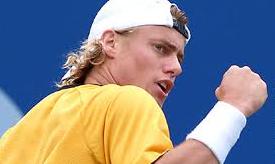 to find out a way to counteract Roger but it’s so difficult to do,” said Henman, “and since he won Wimbledon for the first time his confidence has grown and grown. He’s setting the standards for everybody right now.” The frustrations for Hewitt grew in the 2nd set when he had a break point on the Federer serve only to be bombarded with three consecutive aces. Immediately his own serve was on the rack again but he clung on from 0/40. The Beatles’ Ticket to Ride blared out at the change-over although a Hard Day’s Night might have been more appropriate for Hewitt. There were a few more signs of mortality in Federer’s next service game but at 30/40, with the court open, Hewitt’s backhand clipped the net and went wide. Two more aces and the Swiss was a game away from the second set. Federer’s level had dropped from the first set – he could hardly have raised it – and the Australian was fighting to his physical limits, which are considerable. For the third service game in succession Hewitt troubled Federer, whose first serve had gone missing. Two chances evaded him, then a third when the Swiss manufactured a superb forehand cross-court. But at the fourth attempt the Australian succeeded, Federer hitting a backhand wide for 5:5. It was a huge game for Hewitt
to find out a way to counteract Roger but it’s so difficult to do,” said Henman, “and since he won Wimbledon for the first time his confidence has grown and grown. He’s setting the standards for everybody right now.” The frustrations for Hewitt grew in the 2nd set when he had a break point on the Federer serve only to be bombarded with three consecutive aces. Immediately his own serve was on the rack again but he clung on from 0/40. The Beatles’ Ticket to Ride blared out at the change-over although a Hard Day’s Night might have been more appropriate for Hewitt. There were a few more signs of mortality in Federer’s next service game but at 30/40, with the court open, Hewitt’s backhand clipped the net and went wide. Two more aces and the Swiss was a game away from the second set. Federer’s level had dropped from the first set – he could hardly have raised it – and the Australian was fighting to his physical limits, which are considerable. For the third service game in succession Hewitt troubled Federer, whose first serve had gone missing. Two chances evaded him, then a third when the Swiss manufactured a superb forehand cross-court. But at the fourth attempt the Australian succeeded, Federer hitting a backhand wide for 5:5. It was a huge game for Hewitt 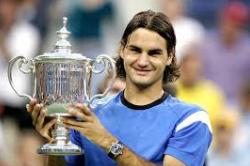 that lasted only five minutes less than the whole first set. Hewitt had been plugging away at Federer’s weaker side, the backhand, to great effect but in the tie-break the world No. 1 rediscovered his first serve. He was clearly edgy, although disappointingly it was Hewitt’s level that dropped, Federer winning the tie-break in a second set last 68 minutes. And that was that. Federer rushed through the 3rd set in 25 minutes, almost a replica of the first. Hewitt, like Henman had tried his best, but Federer is currently a class apart from everyone. “I’m very happy, I still can’t believe what I’ve done this year,” said Federer. “It’s always very important to play well in the finals, in the matches that count, and to win the first set 6-0 was a perfect start.” Federer’s 20th title (4th major). “It’s an incredible effort what he’s done, to win three Grand Slams out of four,” said Hewitt afterwards. “With the depth in men’s tennis the way it is, I don’t think people realize how hard it is.” A double bagel occurred in the US Open finals once before, during the fourth edition in 1884 when Richard Sears defeated fellow American Howard Taylor 6-0, 1-6, 6-0, 6-2. Stats of the final
that lasted only five minutes less than the whole first set. Hewitt had been plugging away at Federer’s weaker side, the backhand, to great effect but in the tie-break the world No. 1 rediscovered his first serve. He was clearly edgy, although disappointingly it was Hewitt’s level that dropped, Federer winning the tie-break in a second set last 68 minutes. And that was that. Federer rushed through the 3rd set in 25 minutes, almost a replica of the first. Hewitt, like Henman had tried his best, but Federer is currently a class apart from everyone. “I’m very happy, I still can’t believe what I’ve done this year,” said Federer. “It’s always very important to play well in the finals, in the matches that count, and to win the first set 6-0 was a perfect start.” Federer’s 20th title (4th major). “It’s an incredible effort what he’s done, to win three Grand Slams out of four,” said Hewitt afterwards. “With the depth in men’s tennis the way it is, I don’t think people realize how hard it is.” A double bagel occurred in the US Open finals once before, during the fourth edition in 1884 when Richard Sears defeated fellow American Howard Taylor 6-0, 1-6, 6-0, 6-2. Stats of the final
***************************************
US Open, New York
August 29-September 11, 2005; 128 Draw (32 seeds); Surface – Hard
First US Open played on blue courts…. 24-year-old Roger Federer became the first man in the Open era to win Wimbledon and the U.S. Open back-to-back two consecutive seasons. 11 years older Andre Agassi played his last great major; he survived three 5-setters in a row en route to the final – the most dramatic one against James Blake, for whom it was the best moment in career. Two 18-year-old boys (Novak Djokovic & Andy Murray) won their first matches at the US Open, both in five sets; during those victories the former suffered cramps having problems with breathing, the latter vomited… Seven years later they will be playing against each other in the US Open final.
First round: Jerry Magee
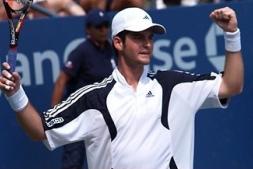 The highest seeded player to lose on the first day among the men was No. 9 Gaston Gaudio, the 2004 French Open champion who was taken out by wild card Brian Baker of Nashville, 7-6(9), 6-2, 6-4. The 20-year-old Baker, sidelined for three months earlier this year with a left wrist injury, came into the tournament ranked No. 197 after laboring mostly on the Challengers tour. “I think I’ve always had it in me,” Baker said of the biggest victory of his career. “I just haven’t quite been able to put it together for a whole match. Ever since I was a little kid, you always dream about being top 10 in the world and winning a Grand Slam. I know that’s a long way away right now, but hopefully with a lot of hard work, getting a little bit better, maybe I can accomplish those things down the road.” In the 1st set tie-break, Gaudio had a set point after saving three. British number two Greg Rusedski joined his compatriot Tim Henman (lost in straight sets to Fernando Verdasco) in crashing out in the first round of the US Open at Flushing Meadow. Despite playing some high quality tennis of his own, the 28th seed was quite simply outplayed by the New York born 25-year-old, James Blake. The American was quite simply magnificent, beating the 1997 runner-up in three sets, 7-5, 7-6(3), 6-3. Fresh from his second ATP tour event win at New Haven last week, the local favourite had far too many shots for the 32-year-old Brit, as he powered into the second round. Having briefly threatened to make a fight out of it, Rusedski eventually succumbed to an impressive array of groundstrokes from Blake. Both players broke serve early in the 1st set, but Rusedski looked the player under more pressure throughout as the athletic Blake moved smoothly around the court. The Brit had a set point at 5:4 in the first, but Blake fought back and broke Rusedski in the next game. Rusedski began the second set in more determined mood, hitting a flurry of early aces to race through his own service games while looking to capitalize on Blake’s serve to try to get himself back into the match. In the 2nd set Rusedski again had a set point – this time double at 6:5* (40/15), but had no answer to Blake’s superb range of shots from the back of the court. Rusedski again started the 3rd set brightly, but he was worn down by a succession of brilliant winners from the exciting young American. Blake broke Rusedski’s serve in the 6th game, with a series of thunderous returns of serve that were just too good for the Brit, and he eventually won the set 6-3. “It was tough to watch,” Blake said. “I kept thinking, ‘I wonder how I’d be doing if I was there.’ Now this year to go out there, it’s just a great feeling.” Unseeded, Blake may not be a threat to win the Open. He’s playing the best tennis of his life at age 25, but he harbors no illusions that he’s in the same class as No. 1 Roger Federer, who won his first-round match against Czech newcomer Ivo Minar 6-1, 6-1, 6-1 in 1 hour, 1 minute earlier in the day. Somebody might remind an 18-year-old player from Serbia named Novak Djokovic [97] of this point. In the most dramatic, controversial match of the U.S. Open’s beginning phase, Djokovic yesterday utilized timeouts as if his opponent were on his 2-yard line – and got away with it. “I had to do it, I just had to, because the weather is so bad,” he said after creating four delays in an opening-round match he eventually seized from Gael Monfils [43] of France in 4 hours, 2 minutes by scores of 7-5, 4-6, 7-6(5), 0-6, 7-5. Suspense was reserved for the Djokovic-Monfils encounter. Its most dramatic moment in a humid, mid-80s afternoon came in the 5th set with the Serb serving at 3:4, 40/40. At this point, Djokovic fell to the surface of Court 10, his chest heaving. A trainer was summoned. About 10 minutes passed before the trainer could get to the court. Djokovic later said he suffers from allergies and that he was experiencing problems breathing. After he caught his breath, he was treated for cramping in his left leg. Earlier, he had received treatment for a professed shoulder problem and for cramping in both calves. “I used all my timeouts,” said Djokovic. If he will check the rule book, he will find that tennis players are not allotted timeouts. “You would just have to be on the court to feel what I was feeling,” Djokovic said. He noted that at the French Open he had to retire from a match against Guillermo Coria when his allergies kicked up. While Djokovic was being treated in the final set, Monfils had to sit there, not at all patiently. He said he became cold. When the match resumed, Djokovic was able
The highest seeded player to lose on the first day among the men was No. 9 Gaston Gaudio, the 2004 French Open champion who was taken out by wild card Brian Baker of Nashville, 7-6(9), 6-2, 6-4. The 20-year-old Baker, sidelined for three months earlier this year with a left wrist injury, came into the tournament ranked No. 197 after laboring mostly on the Challengers tour. “I think I’ve always had it in me,” Baker said of the biggest victory of his career. “I just haven’t quite been able to put it together for a whole match. Ever since I was a little kid, you always dream about being top 10 in the world and winning a Grand Slam. I know that’s a long way away right now, but hopefully with a lot of hard work, getting a little bit better, maybe I can accomplish those things down the road.” In the 1st set tie-break, Gaudio had a set point after saving three. British number two Greg Rusedski joined his compatriot Tim Henman (lost in straight sets to Fernando Verdasco) in crashing out in the first round of the US Open at Flushing Meadow. Despite playing some high quality tennis of his own, the 28th seed was quite simply outplayed by the New York born 25-year-old, James Blake. The American was quite simply magnificent, beating the 1997 runner-up in three sets, 7-5, 7-6(3), 6-3. Fresh from his second ATP tour event win at New Haven last week, the local favourite had far too many shots for the 32-year-old Brit, as he powered into the second round. Having briefly threatened to make a fight out of it, Rusedski eventually succumbed to an impressive array of groundstrokes from Blake. Both players broke serve early in the 1st set, but Rusedski looked the player under more pressure throughout as the athletic Blake moved smoothly around the court. The Brit had a set point at 5:4 in the first, but Blake fought back and broke Rusedski in the next game. Rusedski began the second set in more determined mood, hitting a flurry of early aces to race through his own service games while looking to capitalize on Blake’s serve to try to get himself back into the match. In the 2nd set Rusedski again had a set point – this time double at 6:5* (40/15), but had no answer to Blake’s superb range of shots from the back of the court. Rusedski again started the 3rd set brightly, but he was worn down by a succession of brilliant winners from the exciting young American. Blake broke Rusedski’s serve in the 6th game, with a series of thunderous returns of serve that were just too good for the Brit, and he eventually won the set 6-3. “It was tough to watch,” Blake said. “I kept thinking, ‘I wonder how I’d be doing if I was there.’ Now this year to go out there, it’s just a great feeling.” Unseeded, Blake may not be a threat to win the Open. He’s playing the best tennis of his life at age 25, but he harbors no illusions that he’s in the same class as No. 1 Roger Federer, who won his first-round match against Czech newcomer Ivo Minar 6-1, 6-1, 6-1 in 1 hour, 1 minute earlier in the day. Somebody might remind an 18-year-old player from Serbia named Novak Djokovic [97] of this point. In the most dramatic, controversial match of the U.S. Open’s beginning phase, Djokovic yesterday utilized timeouts as if his opponent were on his 2-yard line – and got away with it. “I had to do it, I just had to, because the weather is so bad,” he said after creating four delays in an opening-round match he eventually seized from Gael Monfils [43] of France in 4 hours, 2 minutes by scores of 7-5, 4-6, 7-6(5), 0-6, 7-5. Suspense was reserved for the Djokovic-Monfils encounter. Its most dramatic moment in a humid, mid-80s afternoon came in the 5th set with the Serb serving at 3:4, 40/40. At this point, Djokovic fell to the surface of Court 10, his chest heaving. A trainer was summoned. About 10 minutes passed before the trainer could get to the court. Djokovic later said he suffers from allergies and that he was experiencing problems breathing. After he caught his breath, he was treated for cramping in his left leg. Earlier, he had received treatment for a professed shoulder problem and for cramping in both calves. “I used all my timeouts,” said Djokovic. If he will check the rule book, he will find that tennis players are not allotted timeouts. “You would just have to be on the court to feel what I was feeling,” Djokovic said. He noted that at the French Open he had to retire from a match against Guillermo Coria when his allergies kicked up. While Djokovic was being treated in the final set, Monfils had to sit there, not at all patiently. He said he became cold. When the match resumed, Djokovic was able 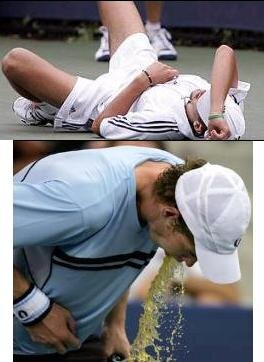 to hold and he went on to gain his first victory in three matches against Monfils (he defeated Djokovic once in a junior event, once Futures – both in 2004), a former world junior champion. “Maybe he ought to change some things,” Monfils said of the winner. “I really played good today,” decided Djokovic. How he flaunted the spirit of tennis’ convention was another matter. Andy Murray [122] struggled through illness and stifling heat before beating Romania’s Andrei Pavel in five dramatic sets in the first round of the US Open. The 18-year-old Scot after taking the match into a final set, he broke early before suddenly being sick on court. Pavel broke back immediately before Murray regained the initiative and held on for a 6-3, 3-6, 3-6, 6-1, 6-4 victory in 3 hours 12 minutes. “That’s my best win, or the one that I’ve enjoyed the most,” the Scot said afterwards. The Scot was leading 2:1 in the final set, with a break of serve, when he was sick on court. The resulting 21-minute delay seemed to revive Pavel who broke back immediately when the match resumed. “This is my 10th week in a row and I have won a five-set match today,” said Murray afterwards. “I showed that I am not in that bad a shape. After what everyone said about me being not fit enough I feel like I’ve proved a lot of people wrong.” Murray broke again in the 7th game as the umpire overruled a line call in the Scot’s favour, prompting a tirade of abuse from Pavel that led to a point penalty. One player who apparently was pain free was Gustavo Kuerten, the three-time Grand Slam winner whose career has been blighted by a hip problem. “I have a lack of power and a lack of playing, too,” the Brazilian said. But he was able to get through a 6-2, 6-7(5), 6-3, 7-6(3) victory over American Paul Goldstein. Like an ageless rock star, Andre Agassi took the court for his 20th straight U.S. Open to roars that drowned out his introduction. No one, not even Agassi, knows if this will be his last U.S. Open, but if it is he started it out in fine fashion with a tidy 69-minute, 6-3, 6-3, 6-1 romp over an overwhelmed and thoroughly outclassed
to hold and he went on to gain his first victory in three matches against Monfils (he defeated Djokovic once in a junior event, once Futures – both in 2004), a former world junior champion. “Maybe he ought to change some things,” Monfils said of the winner. “I really played good today,” decided Djokovic. How he flaunted the spirit of tennis’ convention was another matter. Andy Murray [122] struggled through illness and stifling heat before beating Romania’s Andrei Pavel in five dramatic sets in the first round of the US Open. The 18-year-old Scot after taking the match into a final set, he broke early before suddenly being sick on court. Pavel broke back immediately before Murray regained the initiative and held on for a 6-3, 3-6, 3-6, 6-1, 6-4 victory in 3 hours 12 minutes. “That’s my best win, or the one that I’ve enjoyed the most,” the Scot said afterwards. The Scot was leading 2:1 in the final set, with a break of serve, when he was sick on court. The resulting 21-minute delay seemed to revive Pavel who broke back immediately when the match resumed. “This is my 10th week in a row and I have won a five-set match today,” said Murray afterwards. “I showed that I am not in that bad a shape. After what everyone said about me being not fit enough I feel like I’ve proved a lot of people wrong.” Murray broke again in the 7th game as the umpire overruled a line call in the Scot’s favour, prompting a tirade of abuse from Pavel that led to a point penalty. One player who apparently was pain free was Gustavo Kuerten, the three-time Grand Slam winner whose career has been blighted by a hip problem. “I have a lack of power and a lack of playing, too,” the Brazilian said. But he was able to get through a 6-2, 6-7(5), 6-3, 7-6(3) victory over American Paul Goldstein. Like an ageless rock star, Andre Agassi took the court for his 20th straight U.S. Open to roars that drowned out his introduction. No one, not even Agassi, knows if this will be his last U.S. Open, but if it is he started it out in fine fashion with a tidy 69-minute, 6-3, 6-3, 6-1 romp over an overwhelmed and thoroughly outclassed 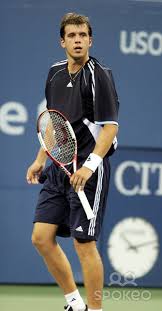 Romanian, Razvan Sabau. Seeded second behind Federer, Rafael Nadal unleashed fiery flashes reminiscent of a young Jimmy Connors amid a workmanlike 6-3, 6-3, 6-4 rout of hard-serving American wild card Bobby Reynolds on a hot, muggy opening day. Gilles Muller [68] of Luxembourg caused a huge upset by defeating Andy Roddick in the first round of the US Open at Flushing Meadows on Tuesday. Roddick, who won the title in 2003, went into the featured night-session match as an overwhelming favourite. But former world junior champion Muller had the measure of the American, dominating the big-serving encounter to win 7-6(4), 7-6(8), 7-6(1). “I love playing here. I probably had the best practice week I’ve ever had.” said Roddick. Muller, who was playing at Flushing Meadows for the first time, believes his relaxed approach to his encounter with Roddick was the key to his win. “I have no idea (how I did it),” Muller said afterwards of the victory on his U.S. Open debut. “For me it was just unbelievable to come out here. I told myself to just enjoy it and I did it every minute.” Roddick wasted two set points in the 2nd tie-break (6:5 & 8:7). There were two breaks of serve, Muller out-aced Roddick 24-16. Jarkko Nieminen made one of the biggest comebacks in the US Open history overcoming Karol Beck 6-4, 2-6, 7-5, 0-6, 7-5. The Finn was able to stop a 10-game losing streak at 0:4* (15/30) in the 5th set. Afterwards won five straight games from 2:5! Beck wasn’t closer than three points away from victory.
Romanian, Razvan Sabau. Seeded second behind Federer, Rafael Nadal unleashed fiery flashes reminiscent of a young Jimmy Connors amid a workmanlike 6-3, 6-3, 6-4 rout of hard-serving American wild card Bobby Reynolds on a hot, muggy opening day. Gilles Muller [68] of Luxembourg caused a huge upset by defeating Andy Roddick in the first round of the US Open at Flushing Meadows on Tuesday. Roddick, who won the title in 2003, went into the featured night-session match as an overwhelming favourite. But former world junior champion Muller had the measure of the American, dominating the big-serving encounter to win 7-6(4), 7-6(8), 7-6(1). “I love playing here. I probably had the best practice week I’ve ever had.” said Roddick. Muller, who was playing at Flushing Meadows for the first time, believes his relaxed approach to his encounter with Roddick was the key to his win. “I have no idea (how I did it),” Muller said afterwards of the victory on his U.S. Open debut. “For me it was just unbelievable to come out here. I told myself to just enjoy it and I did it every minute.” Roddick wasted two set points in the 2nd tie-break (6:5 & 8:7). There were two breaks of serve, Muller out-aced Roddick 24-16. Jarkko Nieminen made one of the biggest comebacks in the US Open history overcoming Karol Beck 6-4, 2-6, 7-5, 0-6, 7-5. The Finn was able to stop a 10-game losing streak at 0:4* (15/30) in the 5th set. Afterwards won five straight games from 2:5! Beck wasn’t closer than three points away from victory.
Second round: (AP), Steve Wilstein
Defending champion Roger Federer was given a tough passage into the third round of the US Open before overcoming Fabrice Santoro 7-5, 7-5, 7-6(2). The Frenchman produced a dazzling array of shots to regularly rattle the world number one and cancel out a 5:1 deficit in the opening set. But Federer broke again in the 12th game to round off the set. He won the 2nd set by the same scoreline before a sublime tie-break in the 3rd, which he won 7/2. “I always enjoy playing against him,” said Federer. “He gave me a lesson that first time I played him (in 1999). He sizzled me with his slices. It’s so different playing against him. We had a great match.” [Santoro beat Federer 6-4, 7-6 in Toulouse ’99.] He was joined in the third 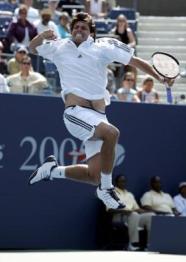 round by Lleyton Hewitt, who also had to see off an unexpectedly tough challenge from Jose Acasuso. Hewitt came through 7-6(6), 7-6(3), 6-2 against the big-hitting Argentine. The turning point of the match came with Hewitt serving at 40/30 in the 12th game of the 2nd set and trying to force another tiebreaker. He double-faulted but the lineswoman failed to call the ball wide, prompting the chair umpire to instruct the players to replay the point. Both players were upset, Hewitt arguing that the umpire should not have overruled if he didn’t clearly see the ball land wide and Acasuso claiming that because the umpire did overrule, he should have been awarded the point. Instead of being ‘deuce’, Hewitt won the replayed point and the rattled Argentine quickly fell behind 6:0 in the tiebreaker, and was unable to recover. Hewitt is likely to be tested yet further in the third round where he faces big-serving Taylor Dent [27], who beat [95] Nicolas Almagro 6-3, 6-2, 4-6, 7-5 in 2 hours 33 minutes serving 17 aces and 9 double faults. Asked about Hewitt’s behaviour on court, Dent said some of it could not be considered “super sportsmanship.” Hewitt responded: “It doesn’t faze me a whole heap. It’s still a matter of me going out there Sunday and playing my game and not worrying about who’s at the other end too much. It’s water off a duck’s back.” And Dent added: “If I was his coach, I’d say keep doing it. At the end of the day, I’m not going to lose the match because he’s cheering on my bad shots.” Paradorn Srichaphan showed flashes of his form of old as he upset sixth seed Nikolay Davydenko 6-4 7-5 6-3. The 26-year-old Thai, a former world number nine, has seen his ranking slide to 51st but was in fine form on Friday. Srichaphan ripped 45 winners against his Russian opponent, who reached the semi-finals at the French Open and the last eight at the Australian Open. The Thai will next face David Sanguinetti, who beat Carlos Moya in four sets. Teenager Andy Murray made an agonizing exit at the US Open, suffering a 6-2, 7-6(2), 2-6, 6-7(4), 6-0 defeat to Frenchman Arnaud Clement in 4 hours 1 minute. The Scot looked poised to complete an incredible comeback when he recovered from two sets down to take the match into a deciding fifth set. But as at Queen’s and Wimbledon earlier this year, the 18-year-old was struck by cramp and ran out of steam. Murray saved three match points at 0:5 but double-faulted on the fourth. The British number three later insisted it was mental rather than physical fatigue that had contributed to his defeat. “It’s not easy coming back
round by Lleyton Hewitt, who also had to see off an unexpectedly tough challenge from Jose Acasuso. Hewitt came through 7-6(6), 7-6(3), 6-2 against the big-hitting Argentine. The turning point of the match came with Hewitt serving at 40/30 in the 12th game of the 2nd set and trying to force another tiebreaker. He double-faulted but the lineswoman failed to call the ball wide, prompting the chair umpire to instruct the players to replay the point. Both players were upset, Hewitt arguing that the umpire should not have overruled if he didn’t clearly see the ball land wide and Acasuso claiming that because the umpire did overrule, he should have been awarded the point. Instead of being ‘deuce’, Hewitt won the replayed point and the rattled Argentine quickly fell behind 6:0 in the tiebreaker, and was unable to recover. Hewitt is likely to be tested yet further in the third round where he faces big-serving Taylor Dent [27], who beat [95] Nicolas Almagro 6-3, 6-2, 4-6, 7-5 in 2 hours 33 minutes serving 17 aces and 9 double faults. Asked about Hewitt’s behaviour on court, Dent said some of it could not be considered “super sportsmanship.” Hewitt responded: “It doesn’t faze me a whole heap. It’s still a matter of me going out there Sunday and playing my game and not worrying about who’s at the other end too much. It’s water off a duck’s back.” And Dent added: “If I was his coach, I’d say keep doing it. At the end of the day, I’m not going to lose the match because he’s cheering on my bad shots.” Paradorn Srichaphan showed flashes of his form of old as he upset sixth seed Nikolay Davydenko 6-4 7-5 6-3. The 26-year-old Thai, a former world number nine, has seen his ranking slide to 51st but was in fine form on Friday. Srichaphan ripped 45 winners against his Russian opponent, who reached the semi-finals at the French Open and the last eight at the Australian Open. The Thai will next face David Sanguinetti, who beat Carlos Moya in four sets. Teenager Andy Murray made an agonizing exit at the US Open, suffering a 6-2, 7-6(2), 2-6, 6-7(4), 6-0 defeat to Frenchman Arnaud Clement in 4 hours 1 minute. The Scot looked poised to complete an incredible comeback when he recovered from two sets down to take the match into a deciding fifth set. But as at Queen’s and Wimbledon earlier this year, the 18-year-old was struck by cramp and ran out of steam. Murray saved three match points at 0:5 but double-faulted on the fourth. The British number three later insisted it was mental rather than physical fatigue that had contributed to his defeat. “It’s not easy coming back 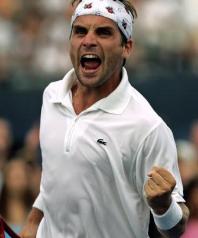 from two sets to love down,” he said. “In the fifth set when I got broken I ran out of gas – I’ve been working very hard over the last nine or 10 weeks. I just lost it after I got broken. I had nothing left, but it was more mental than anything.” The Scot, who came through in five sets against Andrei Pavel in the first round, looked to have dealt Clement a crushing blow when he edged a tight fourth. Murray missed three set points at 5:4, then saved break points against him in the next game as a dramatic set went to a tie-break. With the crowd firmly in his corner, Murray raced into a 5:1 lead and after sealing it 7/4, the teenager looked favourite to clinch the match. But there was another twist to come. Murray, who recently hit out at those who questioned his fitness after Wimbledon, called for the trainer at 0:1. He immediately received treatment for cramp in his right thigh but on his return, his serve had lost all penetration and his movement was clearly restricted. The 18-year-old staged a brief rally in saving match points at 0-5 but he could not lift himself for another unlikely recovery. Andre Agassi stood 11 inches shorter than 6-foot-10 Croatian Ivo Karlovic, spun serves about 50 mph slower, and logged far fewer miles on court. The ace count went to Karlovic, 30-5, as he clocked serves consistently in the 130-142 mph range, but the second-round victory at the U.S. Open on Thursday went to Agassi, 7-6(4), 7-6(5), 7-6(4) – two breaks of serve; Karlovic third time within three years lost an all-tie-break three-setter. At 35, nine years older than the gangling giant across the net, Agassi came up bigger on the big points to continue his run for one more Grand Slam title in his 20th visit to the Open. His wife, Steffi Graf, and 3-year-old son, Jaden, watched at courtside. “Listen to that,” Agassi said as the standing crowd in Arthur Ashe Stadium cheered his victory. “How does that get old? Thanks guys. If I was coaching him, I’d fine him $100 every time he hit a groundstroke. In his most difficult moments, he was more awkward than I anticipated.” The first-set tie-break turned in just such a moment, when Agassi drilled a forehand that Karlovic volleyed wide to give Agassi a mini-break at 5:4. Agassi kept taking aim at Karlovic’s backhand and watched him hit two straight unforced errors off that side to lose the set. Agassi had to go to five set-points in the 2nd set before he won it with a deep forehand that Karlovic swatted long. In the 3rd set, serving with a 5:4 lead in the tie-break, Agassi hit six straight shots at Karlovic’s backhand, then ripped a winner to his open forehand side to set up match point. Again, Agassi picked on Karlovic’s backhand, hitting three shots to that side and watching Karlovic dump the last one into the net. Agassi served mostly in the 80-90 mph range in the wind and played with extra caution in this match, not going for too much against Karlovic. “Today required a lot of concentration because it only took a mental lapse for one or two shots and the set’s over with,” Agassi said. “On a calm day if I’m taking risks against a guy like that, all he needs is one game and then he’s going to win the set. I couldn’t afford to get too risky. Points happen too quickly out there.” Agassi’s wariness was particularly raised after watching No. 4 Andy Roddick fall in three tiebreakers in the first round against Luxembourg’s Gilles Muller. Muller’s luck and poise didn’t hold in the second round as he was beaten 6-1, 6-1, 6-4 by American doubles partner Robby Ginepri. “It’s good to beat Roddick,” Muller said. “But then if you play in the next round … like I did today, it doesn’t change anything.” James Blake set up a third-round match against No. 2 seed Rafael Nadal by beating Igor Andreev 6-2, 6-2, 6-4 in a night match. Blake broke the Russian’s
from two sets to love down,” he said. “In the fifth set when I got broken I ran out of gas – I’ve been working very hard over the last nine or 10 weeks. I just lost it after I got broken. I had nothing left, but it was more mental than anything.” The Scot, who came through in five sets against Andrei Pavel in the first round, looked to have dealt Clement a crushing blow when he edged a tight fourth. Murray missed three set points at 5:4, then saved break points against him in the next game as a dramatic set went to a tie-break. With the crowd firmly in his corner, Murray raced into a 5:1 lead and after sealing it 7/4, the teenager looked favourite to clinch the match. But there was another twist to come. Murray, who recently hit out at those who questioned his fitness after Wimbledon, called for the trainer at 0:1. He immediately received treatment for cramp in his right thigh but on his return, his serve had lost all penetration and his movement was clearly restricted. The 18-year-old staged a brief rally in saving match points at 0-5 but he could not lift himself for another unlikely recovery. Andre Agassi stood 11 inches shorter than 6-foot-10 Croatian Ivo Karlovic, spun serves about 50 mph slower, and logged far fewer miles on court. The ace count went to Karlovic, 30-5, as he clocked serves consistently in the 130-142 mph range, but the second-round victory at the U.S. Open on Thursday went to Agassi, 7-6(4), 7-6(5), 7-6(4) – two breaks of serve; Karlovic third time within three years lost an all-tie-break three-setter. At 35, nine years older than the gangling giant across the net, Agassi came up bigger on the big points to continue his run for one more Grand Slam title in his 20th visit to the Open. His wife, Steffi Graf, and 3-year-old son, Jaden, watched at courtside. “Listen to that,” Agassi said as the standing crowd in Arthur Ashe Stadium cheered his victory. “How does that get old? Thanks guys. If I was coaching him, I’d fine him $100 every time he hit a groundstroke. In his most difficult moments, he was more awkward than I anticipated.” The first-set tie-break turned in just such a moment, when Agassi drilled a forehand that Karlovic volleyed wide to give Agassi a mini-break at 5:4. Agassi kept taking aim at Karlovic’s backhand and watched him hit two straight unforced errors off that side to lose the set. Agassi had to go to five set-points in the 2nd set before he won it with a deep forehand that Karlovic swatted long. In the 3rd set, serving with a 5:4 lead in the tie-break, Agassi hit six straight shots at Karlovic’s backhand, then ripped a winner to his open forehand side to set up match point. Again, Agassi picked on Karlovic’s backhand, hitting three shots to that side and watching Karlovic dump the last one into the net. Agassi served mostly in the 80-90 mph range in the wind and played with extra caution in this match, not going for too much against Karlovic. “Today required a lot of concentration because it only took a mental lapse for one or two shots and the set’s over with,” Agassi said. “On a calm day if I’m taking risks against a guy like that, all he needs is one game and then he’s going to win the set. I couldn’t afford to get too risky. Points happen too quickly out there.” Agassi’s wariness was particularly raised after watching No. 4 Andy Roddick fall in three tiebreakers in the first round against Luxembourg’s Gilles Muller. Muller’s luck and poise didn’t hold in the second round as he was beaten 6-1, 6-1, 6-4 by American doubles partner Robby Ginepri. “It’s good to beat Roddick,” Muller said. “But then if you play in the next round … like I did today, it doesn’t change anything.” James Blake set up a third-round match against No. 2 seed Rafael Nadal by beating Igor Andreev 6-2, 6-2, 6-4 in a night match. Blake broke the Russian’s  serve five times, jumping out to early leads in each set, and never faced a break point on his own delivery. He matched his best effort at this tournament by reaching the third round and has won his 13 of his last 15 matches… He’s fast, he’s flamboyant and he gave French Open champion Nadal fits in a compelling duel between 19-year-olds before fading to a 6-4, 7-5, 6-4 defeat Wednesday night in the second round of the U.S. Open. Scoville Jenkins, from Atlanta, came into the Open courtesy of a wild card and won his first Grand Slam match in the first round after four hours and five sets against qualifier George Bastl. With his dreadlocks flapping as he dashed around the court in a swirling wind against Nadal, Jenkins showed he can be dangerous even when he faces the top players on the tour. Nadal needed all his speed to catch up to Jenkins’ drop volleys and baseline shots. The slim difference between them in each of the three sets was attributable to the Spaniard’s greater consistency and the price Jenkins paid for his daring. Jenkins hit nearly twice as many winners – 45 to Nadal’s 23 – but had far more unforced errors: 49-13. One call in the 2nd set made a huge difference. Jenkins was serving at 5:5, 30-love, when a forehand pass by Nadal was called good. Jenkins, standing near the ball, argued that it was wide, and the fans booing the call agreed with him. Replays appeared to show that the ball was, indeed, wide. But the call stood and the rattled Jenkins double-faulted on the next point, then lost two more for the crucial break that gave Nadal a 6:5 lead he didn’t waste.
serve five times, jumping out to early leads in each set, and never faced a break point on his own delivery. He matched his best effort at this tournament by reaching the third round and has won his 13 of his last 15 matches… He’s fast, he’s flamboyant and he gave French Open champion Nadal fits in a compelling duel between 19-year-olds before fading to a 6-4, 7-5, 6-4 defeat Wednesday night in the second round of the U.S. Open. Scoville Jenkins, from Atlanta, came into the Open courtesy of a wild card and won his first Grand Slam match in the first round after four hours and five sets against qualifier George Bastl. With his dreadlocks flapping as he dashed around the court in a swirling wind against Nadal, Jenkins showed he can be dangerous even when he faces the top players on the tour. Nadal needed all his speed to catch up to Jenkins’ drop volleys and baseline shots. The slim difference between them in each of the three sets was attributable to the Spaniard’s greater consistency and the price Jenkins paid for his daring. Jenkins hit nearly twice as many winners – 45 to Nadal’s 23 – but had far more unforced errors: 49-13. One call in the 2nd set made a huge difference. Jenkins was serving at 5:5, 30-love, when a forehand pass by Nadal was called good. Jenkins, standing near the ball, argued that it was wide, and the fans booing the call agreed with him. Replays appeared to show that the ball was, indeed, wide. But the call stood and the rattled Jenkins double-faulted on the next point, then lost two more for the crucial break that gave Nadal a 6:5 lead he didn’t waste.
Third round: Liza Clarke
This time a year ago, James Blake was so dizzy when he ventured out of his house that he feared he might fall. And when he tried hitting tennis balls again he actually flinched, afraid a ball might smack him in the head because he couldn’t see clearly. His smile was nonexistent. There wasn’t much to smile about, for one, losing his father to stomach cancer and, by all indications, losing a 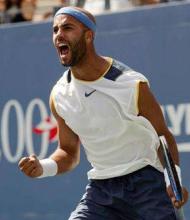 promising tennis career to a broken neck. Had there been cause for joy, he couldn’t express it because one side of his face was paralyzed – a result of the shingles that also damaged his hearing and rattled his balance. On Saturday Blake couldn’t stop smiling after plopping in his courtside seat at the U.S. National Tennis Center, overwhelmed by what he had just accomplished. In toppling the world’s No. 2 player, Rafael Nadal of Spain, 6-4, 4-6, 6-3, 6-1, Blake advanced to the fourth round of the U.S. Open, equaling his best performance in a Grand Slam event, and proved he’s again ready to compete with – and defeat – the world’s best. Blake credited his stunning victory to the new perspective he gained after last season’s struggles and his free-fall in the rankings, from 22nd in the world to 210th. Not a day goes by that he doesn’t think about his father, he said, and that fact that he told him he was proud of his son during one of their last conversations. “He always taught me about work ethic and doing your best and acting appropriately,” Blake said. “I feel like I did that today. Whether I won of lost, I gave 100 percent. I acted according to the manner that I know he would think is appropriate. So if I won or lost this match, I’d like to think that he was proud of me.” The match presented a delightful contrast in styles. The right-handed Blake was determined to attack at every opportunity; the left-handed Nadal was content to counter-punch and wait for the slightest hole in Blake’s net coverage to blast a passing shot by him. Blake knocked the muscle-bound Spaniard on his heels with 10 aces, and he blistered the court with 53 winners while committing just 27 unforced errors. The 1st set stayed on serve until Blake finally broke the Spaniard in the 9th game. It was only the second time Nadal has lost his serve all week. Then he served out the set by yanking Nadal wide for a service winner. Nadal seized the momentum in the 2nd set, getting the break with Blake serving at 4:5 when the American netted a forehand. The
promising tennis career to a broken neck. Had there been cause for joy, he couldn’t express it because one side of his face was paralyzed – a result of the shingles that also damaged his hearing and rattled his balance. On Saturday Blake couldn’t stop smiling after plopping in his courtside seat at the U.S. National Tennis Center, overwhelmed by what he had just accomplished. In toppling the world’s No. 2 player, Rafael Nadal of Spain, 6-4, 4-6, 6-3, 6-1, Blake advanced to the fourth round of the U.S. Open, equaling his best performance in a Grand Slam event, and proved he’s again ready to compete with – and defeat – the world’s best. Blake credited his stunning victory to the new perspective he gained after last season’s struggles and his free-fall in the rankings, from 22nd in the world to 210th. Not a day goes by that he doesn’t think about his father, he said, and that fact that he told him he was proud of his son during one of their last conversations. “He always taught me about work ethic and doing your best and acting appropriately,” Blake said. “I feel like I did that today. Whether I won of lost, I gave 100 percent. I acted according to the manner that I know he would think is appropriate. So if I won or lost this match, I’d like to think that he was proud of me.” The match presented a delightful contrast in styles. The right-handed Blake was determined to attack at every opportunity; the left-handed Nadal was content to counter-punch and wait for the slightest hole in Blake’s net coverage to blast a passing shot by him. Blake knocked the muscle-bound Spaniard on his heels with 10 aces, and he blistered the court with 53 winners while committing just 27 unforced errors. The 1st set stayed on serve until Blake finally broke the Spaniard in the 9th game. It was only the second time Nadal has lost his serve all week. Then he served out the set by yanking Nadal wide for a service winner. Nadal seized the momentum in the 2nd set, getting the break with Blake serving at 4:5 when the American netted a forehand. The 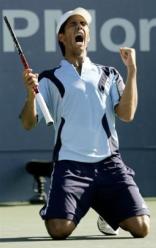 Spaniard pirouetted in the air and skipped to his seat. Instead of doubting his tactics, Blake dug in and drove his ground-strokes harder. Fans rewarded him for every risk, cheering “Blake! Blake! Blake!” when he won the point and “Blake! Blake! Blake!” when he lost a point. Nadal paid dearly for a few sloppy points in the 3rd set. Blake broke him with a perfectly placed lob in the 5th game and broke him again on another lob to close the set, 6-3. After that the confidence seemed to drain from Nadal’s body, and Blake rolled through the decisive set in 23 minutes, winning 16 of the last 17 points. “He has a very good forehand. He’s fast. And he plays with confidence,” said Nadal, whose nine titles this season (including the French Open) are matched only by world No. 1 Roger Federer. Fernando Verdasco [48] advanced to the fourth round of a Grand Slam tournament for the first time after defeating Novak Djokovic 6-1, 4-6, 6-7(2), 6-4, 6-4 in 3 hours 4 minutes. The Spaniard served 13 aces and committed 13 double faults. He led *5:2 in the 5th set, but the teenager had a break point to level at 5 games apiece. In vanquishing Nadal, Blake moved one round closer to a quarterfinal meeting with Andre Agassi, his hero, on Wednesday. Agassi did his part to develop the storyline later in the day, defeating Tomas Berdych of the Czech Republic, 3-6, 6-1, 6-4, 7-6(2). Berdych served for the 4th set at 5:3. “The first set was pretty scratchy but each set my quality picked up,” said Agassi. “I just hung on and played a good tie-breaker.” American Robby Ginepri defeated Tommy Haas of Germany, 7-5, 6-7(3), 6-4, 2-6, 6-3, for the right to join Blake and Agassi in the fourth round. Third
Spaniard pirouetted in the air and skipped to his seat. Instead of doubting his tactics, Blake dug in and drove his ground-strokes harder. Fans rewarded him for every risk, cheering “Blake! Blake! Blake!” when he won the point and “Blake! Blake! Blake!” when he lost a point. Nadal paid dearly for a few sloppy points in the 3rd set. Blake broke him with a perfectly placed lob in the 5th game and broke him again on another lob to close the set, 6-3. After that the confidence seemed to drain from Nadal’s body, and Blake rolled through the decisive set in 23 minutes, winning 16 of the last 17 points. “He has a very good forehand. He’s fast. And he plays with confidence,” said Nadal, whose nine titles this season (including the French Open) are matched only by world No. 1 Roger Federer. Fernando Verdasco [48] advanced to the fourth round of a Grand Slam tournament for the first time after defeating Novak Djokovic 6-1, 4-6, 6-7(2), 6-4, 6-4 in 3 hours 4 minutes. The Spaniard served 13 aces and committed 13 double faults. He led *5:2 in the 5th set, but the teenager had a break point to level at 5 games apiece. In vanquishing Nadal, Blake moved one round closer to a quarterfinal meeting with Andre Agassi, his hero, on Wednesday. Agassi did his part to develop the storyline later in the day, defeating Tomas Berdych of the Czech Republic, 3-6, 6-1, 6-4, 7-6(2). Berdych served for the 4th set at 5:3. “The first set was pretty scratchy but each set my quality picked up,” said Agassi. “I just hung on and played a good tie-breaker.” American Robby Ginepri defeated Tommy Haas of Germany, 7-5, 6-7(3), 6-4, 2-6, 6-3, for the right to join Blake and Agassi in the fourth round. Third 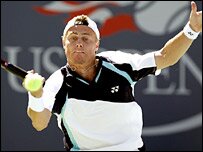 seed Lleyton Hewitt teetered on the brink of defeat before finally seeing off Taylor Dent 6-3, 3-6, 6-7(2), 6-2, 7-5 at the US Open. Hewitt moved into the last 16 after battling for 3 hours 21 minutes. There was no sign of the drama to come when Hewitt raced into a 5:0* lead in the 1st set but Dent banished his nerves and went two sets to one up. Hewitt looked in control when he broke to lead 4:3 in the decider. But there was to be another twist, Hewitt blowing a 40/15 lead in the very next game with two double-faults, a backhand error and a forehand that sailed over the baseline to gift Dent a massive reprieve. Both players held for 5:5 before Hewitt’s famous never-say-die attitude came to the fore. Serving in the 11th game, Dent could only marvel as Hewitt’s incredible retrieving set up two break points and the South Australian converted with a forehand winner and this time there was no way back for the American. “It was tough conditions out there today. The wind was swirling and Taylor’s never going to give you the match. He’s a tough competitor and I really had to earn it,” Hewitt said. Hewill now face Slovakian Dominik Hrbaty, who edged out Spain’s David Ferrer 6-7(7), 7-5, 7-5, 7-5 in 3 hours 7 minutes. Hewitt is seeded to face Roger Federer in the semi-finals but the third seed said he was trying not to think ahead. “I can’t look too far down the line. Obviously Federer is going to be waiting there, most likely. But you can’t look too far ahead of yourself,” he said. “You’ve seen what happened to Nadal and Roddick, there’s no easy matches.” Federer dispatched Olivier Rochus 6-3, 7-6(6), 6-2 erasing a 3:5 deficit in the tie-break. The 33-year-old Davide Sanguinetti, the second-oldest player remaining in the United States Open draw, outlasted Paradorn Srichaphan, 6-3, 4-6, 6-7(2), 7-6(6), 7-6(5), in a match yesterday that lasted 4 hours 24 minutes. It was the longest match of the tournament. Sanguinetti fell to his
seed Lleyton Hewitt teetered on the brink of defeat before finally seeing off Taylor Dent 6-3, 3-6, 6-7(2), 6-2, 7-5 at the US Open. Hewitt moved into the last 16 after battling for 3 hours 21 minutes. There was no sign of the drama to come when Hewitt raced into a 5:0* lead in the 1st set but Dent banished his nerves and went two sets to one up. Hewitt looked in control when he broke to lead 4:3 in the decider. But there was to be another twist, Hewitt blowing a 40/15 lead in the very next game with two double-faults, a backhand error and a forehand that sailed over the baseline to gift Dent a massive reprieve. Both players held for 5:5 before Hewitt’s famous never-say-die attitude came to the fore. Serving in the 11th game, Dent could only marvel as Hewitt’s incredible retrieving set up two break points and the South Australian converted with a forehand winner and this time there was no way back for the American. “It was tough conditions out there today. The wind was swirling and Taylor’s never going to give you the match. He’s a tough competitor and I really had to earn it,” Hewitt said. Hewill now face Slovakian Dominik Hrbaty, who edged out Spain’s David Ferrer 6-7(7), 7-5, 7-5, 7-5 in 3 hours 7 minutes. Hewitt is seeded to face Roger Federer in the semi-finals but the third seed said he was trying not to think ahead. “I can’t look too far down the line. Obviously Federer is going to be waiting there, most likely. But you can’t look too far ahead of yourself,” he said. “You’ve seen what happened to Nadal and Roddick, there’s no easy matches.” Federer dispatched Olivier Rochus 6-3, 7-6(6), 6-2 erasing a 3:5 deficit in the tie-break. The 33-year-old Davide Sanguinetti, the second-oldest player remaining in the United States Open draw, outlasted Paradorn Srichaphan, 6-3, 4-6, 6-7(2), 7-6(6), 7-6(5), in a match yesterday that lasted 4 hours 24 minutes. It was the longest match of the tournament. Sanguinetti fell to his 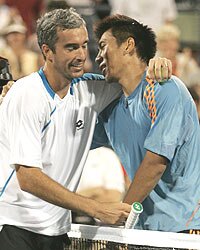 knees after hitting an overhead volley for the last of his 49 winners. He had dropped to the ground a few points earlier, his legs cramping as he made a final push to close out Srichaphan, a 26-year-old from Thailand. The exhausted players fell into each other’s arms at the net after a match that encompassed 377 points, 30 break-point opportunities (13 of which were converted), 112 winners, 126 unforced errors and 21 aces, not to mention the numerous winks and nods and wan smiles exchanged between the unseeded, unbowed players. In the Open field, only Agassi, 35, is older than Sanguinetti. “It’s a good match,” Sanguinetti said. “Today it was like I had fun, so I was laughing with Paradorn.” Srichaphan played near-perfect tennis in the 2nd and 3rd sets, but Sanguinetti was steadier down the stretch, producing 15 winners against 13 unforced errors in the deciding set. He converted 66 percent of his first serves for the match, versus 57 percent for Srichaphan. “I tried very hard to play my best,” said Srichaphan, who fought back from a 4:1* deficit in the 5th set. “My opponent today was very tough to beat. We played a lot of balls side to side. I think it’s one of the best matches that I’ve played.” The Italian, who had been two points awy from losing in four sets, saved a few mini-match point at 5-all in the 5th set – that 11th game went to ‘deuce’ six times. In the deciding tie-break he squandered first two match points before sealing the victory on serve.
knees after hitting an overhead volley for the last of his 49 winners. He had dropped to the ground a few points earlier, his legs cramping as he made a final push to close out Srichaphan, a 26-year-old from Thailand. The exhausted players fell into each other’s arms at the net after a match that encompassed 377 points, 30 break-point opportunities (13 of which were converted), 112 winners, 126 unforced errors and 21 aces, not to mention the numerous winks and nods and wan smiles exchanged between the unseeded, unbowed players. In the Open field, only Agassi, 35, is older than Sanguinetti. “It’s a good match,” Sanguinetti said. “Today it was like I had fun, so I was laughing with Paradorn.” Srichaphan played near-perfect tennis in the 2nd and 3rd sets, but Sanguinetti was steadier down the stretch, producing 15 winners against 13 unforced errors in the deciding set. He converted 66 percent of his first serves for the match, versus 57 percent for Srichaphan. “I tried very hard to play my best,” said Srichaphan, who fought back from a 4:1* deficit in the 5th set. “My opponent today was very tough to beat. We played a lot of balls side to side. I think it’s one of the best matches that I’ve played.” The Italian, who had been two points awy from losing in four sets, saved a few mini-match point at 5-all in the 5th set – that 11th game went to ‘deuce’ six times. In the deciding tie-break he squandered first two match points before sealing the victory on serve.
Fourth round: (Mail Online)
German Nicolas Kiefer gave top seed Roger Federer all he could handle before succumbing to the Swiss world number one 6-4, 6-7(3), 6-4, 6-3 in the US Open. Federer had posted three consecutive straight-sets victories, although he had lengthy matches with Santoro and 27th seed Olivier Rochus the previous two rounds. Those challenges paled in comparison to the fight Kiefer gave Federer, who dropped a set for the first time in 11 Grand Slam 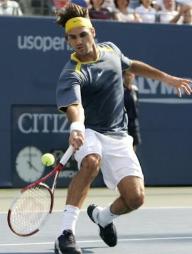 matches. Despite his inconsistent play, Federer did enough to advance, breaking Kiefer five times, including at least once in each set. In the 4th set, Federer broke Kiefer in the 3rd game, then held thereafter, closing out the match in 3 hours 2 minutes with a crosscourt forehand winner that barely stayed in. “I feel very good right now because that was a tough match,” said Federer, who beat Kiefer for the sixth straight time, and won his 32nd consecutive hardcourt match improving to 42-1 on the surface and 68-3 overall this year. The defending US Open champion committed an uncharacteristic 33 unforced errors against 43 winners. Kiefer had 48 winners but 46 unforced errors, including 11 double-faults. Next up for Federer is 11th seed David Nalbandian of Argentina, a 4-6, 7-6(4), 6-4, 6-2 winner over Italy’s Davide Sanguinetti. Federer has won just two of his seven encounters with Nalbandian, though he has won the last two. “I have got a bad record versus Nalbandian, so I would like to play him,” Federer said after the match. Nalbandian has made the quarter-finals in two of the first three majors this year while Sanguinetti has not made it that far in a Grand Slam since Wimbledon in 1998. Federer’s victim in the final here last year, Australian Lleyton Hewitt, had a considerably easier time. The third-seeded Hewitt advanced to the quarter-finals with an easy 6-1, 6-4, 6-2 victory over 15th seed Dominik Hrbaty of Slovakia. “It’s always nice to get through, especially coming off a match like Taylor, which could have gone either way in a lot of ways, only a couple points here and there,” Hewitt said. “It’s nice to go out there and bounce back like I did. It’s even better after playing a long match and you pull up and your body feels good as well. You don’t have any doubts in your mind about your body – that’s a huge positive.” Hewitt began the Open with an easy victory over Spain’s Albert Costa but in his next two matches, against Argentine Jose Acasuso and Dent, he needed a combined five hours 48 minutes to win. As such, Hewitt and coach Roger Rasheed developed a game plan that would get him finished quicker. “I wasn’t trying to go out there and make it into a marathon match,” Hewitt said. Hewitt won the first set easily, took the final three games of the 2nd set and, after falling behind 1:2 in the 3rd, the 24-year-old Aussie won the last five games to complete the match in 94 minutes. The 2001 US Open champion and runner-up last year, Hewitt clinched the match with two of his 11 aces in the final game. Hewitt finished with just 15 unforced errors while Hrbaty committed 49. Hewitt, who reached the quarter-finals at the Open for the sixth straight year, is one match away from a potential semi-final encounter with Federer. But Hewitt first must get past Jarkko Nieminen, who became the first Finn to reach the quarter-finals of a Grand Slam with a 6-2, 7-6(6), 6-3 victory over Spain’s Fernando Verdasco. In the only match-up between left handers at the US Open, Nieminen had only 14 winners, including just 1 ace, but committed just 14 unforced errors. Verdasco, who had won 11 of his previous 13 matches, had 45 winners but committed 66 unforced errors. After dropping the 2nd set, in which he held a set point in the tiebreaker, the Spaniard slammed his racket to the ground… Andre Agassi absorbed two sets of free-swinging, big-serving brilliance from Belgium’s unpredictable Xavier Malisse before coming on very strong in the fifth to win 6-3, 6-4, 6-7(5), 4-6, 6-2. Agassi looked to be in deep trouble after Malisse stormed through the fourth set. “The standard he set in the third and fourth was really high,” Agassi said. “I needed to answer that. I did in the fifth.” Agassi took more risks with his serve and converted 16 of 19 into points. The 35-year-old Agassi led by two sets and 5:3 in the 3rd-set tie-breaker, but Malisse stormed back to level the match, only for the American to snatch the fifth and deciding set. With the crowd chanting his name, Agassi broke Malisse in the 6th game of the final set, then stunned the Belgian with three aces in a row to lead 5:2. He grabbed two quick points on Malisse’s serve, then capped the afternoon on double-match point. Agassi is the first player over 25 to get this far since Jimmy Connors made his run to the semi-finals as a 39-year-old in 1991. James Blake went next, shaking himself free of a sluggish, slightly dispirited start with some help from his edgy, 19th-seeded Spanish opponent Tommy Robredo to win 4-6, 7-5, 6-2, 6-3. Now, the 35-year-old Agassi and 25-year-old Blake will face each other in a
matches. Despite his inconsistent play, Federer did enough to advance, breaking Kiefer five times, including at least once in each set. In the 4th set, Federer broke Kiefer in the 3rd game, then held thereafter, closing out the match in 3 hours 2 minutes with a crosscourt forehand winner that barely stayed in. “I feel very good right now because that was a tough match,” said Federer, who beat Kiefer for the sixth straight time, and won his 32nd consecutive hardcourt match improving to 42-1 on the surface and 68-3 overall this year. The defending US Open champion committed an uncharacteristic 33 unforced errors against 43 winners. Kiefer had 48 winners but 46 unforced errors, including 11 double-faults. Next up for Federer is 11th seed David Nalbandian of Argentina, a 4-6, 7-6(4), 6-4, 6-2 winner over Italy’s Davide Sanguinetti. Federer has won just two of his seven encounters with Nalbandian, though he has won the last two. “I have got a bad record versus Nalbandian, so I would like to play him,” Federer said after the match. Nalbandian has made the quarter-finals in two of the first three majors this year while Sanguinetti has not made it that far in a Grand Slam since Wimbledon in 1998. Federer’s victim in the final here last year, Australian Lleyton Hewitt, had a considerably easier time. The third-seeded Hewitt advanced to the quarter-finals with an easy 6-1, 6-4, 6-2 victory over 15th seed Dominik Hrbaty of Slovakia. “It’s always nice to get through, especially coming off a match like Taylor, which could have gone either way in a lot of ways, only a couple points here and there,” Hewitt said. “It’s nice to go out there and bounce back like I did. It’s even better after playing a long match and you pull up and your body feels good as well. You don’t have any doubts in your mind about your body – that’s a huge positive.” Hewitt began the Open with an easy victory over Spain’s Albert Costa but in his next two matches, against Argentine Jose Acasuso and Dent, he needed a combined five hours 48 minutes to win. As such, Hewitt and coach Roger Rasheed developed a game plan that would get him finished quicker. “I wasn’t trying to go out there and make it into a marathon match,” Hewitt said. Hewitt won the first set easily, took the final three games of the 2nd set and, after falling behind 1:2 in the 3rd, the 24-year-old Aussie won the last five games to complete the match in 94 minutes. The 2001 US Open champion and runner-up last year, Hewitt clinched the match with two of his 11 aces in the final game. Hewitt finished with just 15 unforced errors while Hrbaty committed 49. Hewitt, who reached the quarter-finals at the Open for the sixth straight year, is one match away from a potential semi-final encounter with Federer. But Hewitt first must get past Jarkko Nieminen, who became the first Finn to reach the quarter-finals of a Grand Slam with a 6-2, 7-6(6), 6-3 victory over Spain’s Fernando Verdasco. In the only match-up between left handers at the US Open, Nieminen had only 14 winners, including just 1 ace, but committed just 14 unforced errors. Verdasco, who had won 11 of his previous 13 matches, had 45 winners but committed 66 unforced errors. After dropping the 2nd set, in which he held a set point in the tiebreaker, the Spaniard slammed his racket to the ground… Andre Agassi absorbed two sets of free-swinging, big-serving brilliance from Belgium’s unpredictable Xavier Malisse before coming on very strong in the fifth to win 6-3, 6-4, 6-7(5), 4-6, 6-2. Agassi looked to be in deep trouble after Malisse stormed through the fourth set. “The standard he set in the third and fourth was really high,” Agassi said. “I needed to answer that. I did in the fifth.” Agassi took more risks with his serve and converted 16 of 19 into points. The 35-year-old Agassi led by two sets and 5:3 in the 3rd-set tie-breaker, but Malisse stormed back to level the match, only for the American to snatch the fifth and deciding set. With the crowd chanting his name, Agassi broke Malisse in the 6th game of the final set, then stunned the Belgian with three aces in a row to lead 5:2. He grabbed two quick points on Malisse’s serve, then capped the afternoon on double-match point. Agassi is the first player over 25 to get this far since Jimmy Connors made his run to the semi-finals as a 39-year-old in 1991. James Blake went next, shaking himself free of a sluggish, slightly dispirited start with some help from his edgy, 19th-seeded Spanish opponent Tommy Robredo to win 4-6, 7-5, 6-2, 6-3. Now, the 35-year-old Agassi and 25-year-old Blake will face each other in a 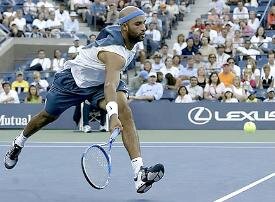 cross-generational, all-American quarterfinal that few would have predicted when this Grand Slam tournament began and even fewer would have predicted a year ago when Blake was watching this tournament on television and unable to blink his left eye because that side of his face was paralyzed by a viral infection. “Listen, James is an easy guy to like, and he’s an easy guy to root for,” Agassi said while Blake’s match with Robredo was still under way. “If he’s getting the better of me, if we happen to play, you know I couldn’t wish it for a better person. He deserves support. I just hope it will be a great standard match.” For most of the first two sets against Blake, the acrobatic Robredo controlled play with appropriate ease for someone whose parents named him after the Who’s pinball-wizard protagonist Tommy. Meanwhile, Blake still seemed to be digesting the impact of the previous round, when he pulled off one of the biggest upsets of the season in grand style against Robredo’s Davis Cup teammate: the No. 2 seed Rafael Nadal. “We were both concerned about that,” said Blake’s coach Brian Barker. “That was the single number one thing we talked about yesterday. We didn’t talk about the Nadal match at all. All we did was talk about Robredo, and how hard it’s going to be to play a top 20 player.” It looked very hard indeed when Robredo had a set point leading 5:2 on Blake’s serve in the 2nd set that would have given him a two-set lead. But Blake shrugged off his compromising position to come up with a mid-court forehand volley winner off a good passing shot and then held serve. In the next game, Robredo double faulted twice to lose his serve and would double fault again on break point at 5:5. Blake, his punch regained, would close out the set, having reeled off five games in a row. “When you have a big chance like this and you don’t get it, then it’s tough, no?” Robredo said. “I gave him the chance to survive, and then he just kill me.” It was not quite that clear cut, as Robredo’s flowing versatility continued to generate suspense early in the fourth set, but Blake would retain his edge in the backcourt and frontcourt on his way to his first appearance in a Grand Slam quarterfinal. Agassi holds a 3-1 career edge over Blake, they have not played since 2003. While Agassi and Blake advanced in bright sunlight, Robby Ginepri had to
cross-generational, all-American quarterfinal that few would have predicted when this Grand Slam tournament began and even fewer would have predicted a year ago when Blake was watching this tournament on television and unable to blink his left eye because that side of his face was paralyzed by a viral infection. “Listen, James is an easy guy to like, and he’s an easy guy to root for,” Agassi said while Blake’s match with Robredo was still under way. “If he’s getting the better of me, if we happen to play, you know I couldn’t wish it for a better person. He deserves support. I just hope it will be a great standard match.” For most of the first two sets against Blake, the acrobatic Robredo controlled play with appropriate ease for someone whose parents named him after the Who’s pinball-wizard protagonist Tommy. Meanwhile, Blake still seemed to be digesting the impact of the previous round, when he pulled off one of the biggest upsets of the season in grand style against Robredo’s Davis Cup teammate: the No. 2 seed Rafael Nadal. “We were both concerned about that,” said Blake’s coach Brian Barker. “That was the single number one thing we talked about yesterday. We didn’t talk about the Nadal match at all. All we did was talk about Robredo, and how hard it’s going to be to play a top 20 player.” It looked very hard indeed when Robredo had a set point leading 5:2 on Blake’s serve in the 2nd set that would have given him a two-set lead. But Blake shrugged off his compromising position to come up with a mid-court forehand volley winner off a good passing shot and then held serve. In the next game, Robredo double faulted twice to lose his serve and would double fault again on break point at 5:5. Blake, his punch regained, would close out the set, having reeled off five games in a row. “When you have a big chance like this and you don’t get it, then it’s tough, no?” Robredo said. “I gave him the chance to survive, and then he just kill me.” It was not quite that clear cut, as Robredo’s flowing versatility continued to generate suspense early in the fourth set, but Blake would retain his edge in the backcourt and frontcourt on his way to his first appearance in a Grand Slam quarterfinal. Agassi holds a 3-1 career edge over Blake, they have not played since 2003. While Agassi and Blake advanced in bright sunlight, Robby Ginepri had to 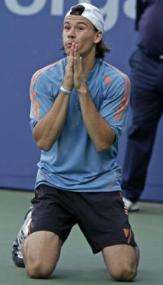 wait until forty minutes after midnight to become the third American in the quarterfinals. Despite some phenomenal shot-making from the French 19-year-old Richard Gasquet, the unseeded Ginepri proved the physically stronger player down the stretch and rallied to win, 6-3, 3-6, 6-7(8), 6-4, 6-0. Gasquet wilted late in the 4th set with arm and stomach problems. Argentine eighth seed Guillermo Coria, who won a bad-tempered fourth round marathon against Chile’s Nicolas Massu 6-4, 2-6, 6-7(5), 6-2, 6-2. Coria’s match with Massu saw heated verbal exchanges in a 4-hour, 32-minute match on Louis Armstrong Court, with Olympic champion Massu apparently angered by Coria’s behavior. Grand slam supervisor Mike Morrissey had to come on to the court to ask them to calm down, with Coria leading 2:1 in the 5th set, after the two players traded insults from their chairs during the changeover. Coria eventually prevailed to reach the quarterfinals for the second time in three years, greeting victory by falling to one knee with his finger raised before jumping the net to exchange the briefest of handshakes with Massu. “There were no words exchanged,” Coria said. “I had an injury with three of my toenails, he implied that I was faking it, and I told him to go sit. In four and a half hours, that was it. There were no bad words.” Massu stated: “I have not had any problems with Guillermo. I never felt we had a rivalry. But he was showing an attitude I didn’t like. He should know if he did right or wrong. I hope it was just a misunderstanding, and if it was, we can talk about it later. If he wants to apologize, that’s fine.”
wait until forty minutes after midnight to become the third American in the quarterfinals. Despite some phenomenal shot-making from the French 19-year-old Richard Gasquet, the unseeded Ginepri proved the physically stronger player down the stretch and rallied to win, 6-3, 3-6, 6-7(8), 6-4, 6-0. Gasquet wilted late in the 4th set with arm and stomach problems. Argentine eighth seed Guillermo Coria, who won a bad-tempered fourth round marathon against Chile’s Nicolas Massu 6-4, 2-6, 6-7(5), 6-2, 6-2. Coria’s match with Massu saw heated verbal exchanges in a 4-hour, 32-minute match on Louis Armstrong Court, with Olympic champion Massu apparently angered by Coria’s behavior. Grand slam supervisor Mike Morrissey had to come on to the court to ask them to calm down, with Coria leading 2:1 in the 5th set, after the two players traded insults from their chairs during the changeover. Coria eventually prevailed to reach the quarterfinals for the second time in three years, greeting victory by falling to one knee with his finger raised before jumping the net to exchange the briefest of handshakes with Massu. “There were no words exchanged,” Coria said. “I had an injury with three of my toenails, he implied that I was faking it, and I told him to go sit. In four and a half hours, that was it. There were no bad words.” Massu stated: “I have not had any problems with Guillermo. I never felt we had a rivalry. But he was showing an attitude I didn’t like. He should know if he did right or wrong. I hope it was just a misunderstanding, and if it was, we can talk about it later. If he wants to apologize, that’s fine.”
Quarterfinals: Steve Wilstein
Robby Ginepri [46], an unsung, unseeded American toiling hard through the U.S. Open, gutted his way out of trouble and got the gift of Guillermo Coria‘s 13th and 14th double-faults on the last two points to reach a Grand Slam semifinal for the first time. Ginepri, a 22-year-old who had never  gone beyond the third round of the Open, won his third straight five-setter against a seeded player, 4-6, 6-1, 7-5, 3-6, 7-5 in 181 minutes. “The last three matches took so much out of me, I’m just dead right now,” Ginepri told the crowd as his family, suffering and celebrating on alternate points, watched from the players’ box. His sister, Jenni, took photos as he spoke. “I don’t know how I got through that match. I don’t know what’s going on right now. I’m a little foggy, a little dizzy. It’s crazy. Crazy!” Ginepri’s victory over the No. 8 Coria, the Argentine who was a French Open finalist last year, ended with a dramatic series of six match points. Coria overcame three match points after a double-fault to love-40 in the 10th game of the final set as the two players, each wearing white caps backward, engaged in long rallies. Coria was involved in a tempest with Chilean Nicolas Massu in his previous match, but against Ginepri there was nothing but respect. On one point earlier in the 5th set, the players gave each other a high-five at the net when they combined for a particularly thrilling point – a beautifully angled drop shot by Coria, a full-court running scoop by Ginepri feathered barely over the net, and a put-away backhand half-volley winner by Coria. Now trailing 4:5, Coria saved the second match point with a backhand, and the third with a brazen overhead from the baseline that skipped off the top of the net cord. He held to 5:5 after one more long rally. After serving his ninth ace at 124 mph to hold for a 6:5 lead in the 5th set, Ginepri jumped out to his fourth match point at 30/40 on Coria’s serve when the wearying Argentine slapped a forehand just wide. Nervous, Ginepri pulled the front of his yellow shirt up to chomp on it with his teeth, then tried to close out the match. Instead, he saw Coria save the point with a forehand that Ginepri stretched to reach but netted. Three points later, Coria mis-hit a backhand wide to give Ginepri a fifth match point. Coria saved that with a surprising serve and volley. That was all Coria had left. He double-faulted to set up the sixth match point and double-faulted again to lose. Coria said he had been having problems with the nerve in his right hand and wasn’t able to grip the racket hard. “I was losing feeling on the hand,” Coria said in Spanish while motioning with his right pinkie. “It has been happening for four days. I had a lot of treatment… but during the match, the more I serve, the more it gets tight – the forearm, the shoulder. I knew it could happen. That’s just the way it is.” Coria, who missed last year’s Open because of a shoulder injury that needed surgery, said he was worn out by his five-set victory over Massu two days earlier – at 4 hours, 32 minutes the longest match of the tournament. “It was a tough break that the match with Massu was so long,” Coria said. “My whole body was hurting. It was hard to keep up the same speed I had. But I gave it all — ran, tried hard and gave it all I could. He won because he deserved it. He’s been waiting for a moment like this for a long time.” Andre Agassi, 35 years young, took a pounding for two sets from a sizzling James Blake, pounced back at him for two more, then survived a tiebreaker in a wondrous five-set drama 3-6, 3-6, 6-3, 6-3, 7-6(6), reminiscent of Jimmy Connors‘ legendary run to the U.S. Open semifinals at 39. “It’s all a big blur right now,” Agassi said of his 2-hour, 51-minute duel with Blake, which ended with Agassi’s final forehand winner smacking the sideline. “It’s always great when the end of a match is decided by quality shots and somebody winning it instead of somebody losing it. I question myself every day. That’s what I still find motivating about this. I
gone beyond the third round of the Open, won his third straight five-setter against a seeded player, 4-6, 6-1, 7-5, 3-6, 7-5 in 181 minutes. “The last three matches took so much out of me, I’m just dead right now,” Ginepri told the crowd as his family, suffering and celebrating on alternate points, watched from the players’ box. His sister, Jenni, took photos as he spoke. “I don’t know how I got through that match. I don’t know what’s going on right now. I’m a little foggy, a little dizzy. It’s crazy. Crazy!” Ginepri’s victory over the No. 8 Coria, the Argentine who was a French Open finalist last year, ended with a dramatic series of six match points. Coria overcame three match points after a double-fault to love-40 in the 10th game of the final set as the two players, each wearing white caps backward, engaged in long rallies. Coria was involved in a tempest with Chilean Nicolas Massu in his previous match, but against Ginepri there was nothing but respect. On one point earlier in the 5th set, the players gave each other a high-five at the net when they combined for a particularly thrilling point – a beautifully angled drop shot by Coria, a full-court running scoop by Ginepri feathered barely over the net, and a put-away backhand half-volley winner by Coria. Now trailing 4:5, Coria saved the second match point with a backhand, and the third with a brazen overhead from the baseline that skipped off the top of the net cord. He held to 5:5 after one more long rally. After serving his ninth ace at 124 mph to hold for a 6:5 lead in the 5th set, Ginepri jumped out to his fourth match point at 30/40 on Coria’s serve when the wearying Argentine slapped a forehand just wide. Nervous, Ginepri pulled the front of his yellow shirt up to chomp on it with his teeth, then tried to close out the match. Instead, he saw Coria save the point with a forehand that Ginepri stretched to reach but netted. Three points later, Coria mis-hit a backhand wide to give Ginepri a fifth match point. Coria saved that with a surprising serve and volley. That was all Coria had left. He double-faulted to set up the sixth match point and double-faulted again to lose. Coria said he had been having problems with the nerve in his right hand and wasn’t able to grip the racket hard. “I was losing feeling on the hand,” Coria said in Spanish while motioning with his right pinkie. “It has been happening for four days. I had a lot of treatment… but during the match, the more I serve, the more it gets tight – the forearm, the shoulder. I knew it could happen. That’s just the way it is.” Coria, who missed last year’s Open because of a shoulder injury that needed surgery, said he was worn out by his five-set victory over Massu two days earlier – at 4 hours, 32 minutes the longest match of the tournament. “It was a tough break that the match with Massu was so long,” Coria said. “My whole body was hurting. It was hard to keep up the same speed I had. But I gave it all — ran, tried hard and gave it all I could. He won because he deserved it. He’s been waiting for a moment like this for a long time.” Andre Agassi, 35 years young, took a pounding for two sets from a sizzling James Blake, pounced back at him for two more, then survived a tiebreaker in a wondrous five-set drama 3-6, 3-6, 6-3, 6-3, 7-6(6), reminiscent of Jimmy Connors‘ legendary run to the U.S. Open semifinals at 39. “It’s all a big blur right now,” Agassi said of his 2-hour, 51-minute duel with Blake, which ended with Agassi’s final forehand winner smacking the sideline. “It’s always great when the end of a match is decided by quality shots and somebody winning it instead of somebody losing it. I question myself every day. That’s what I still find motivating about this. I 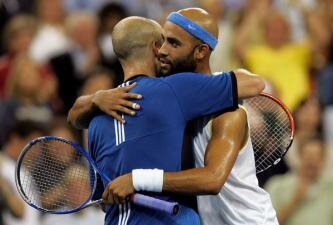 don’t have the answers, I don’t pretend that I do just because I won the match. Just keep fighting and maybe something good happens.” Agassi, playing in his 20th straight U.S. Open, said that a match like this one against Blake “Means as much to me as doing it in the finals. It’s about authentic competition, getting out there and having respect for each other’s game, respect for each other’s person, letting it fly and letting it just be about tennis,” he said. “It’s all a bit surreal. I get out there and I try to work and I come off the court and many times in my career I feel like it’s been a dream. That’s how it is here. It’s a dream to be doing this. I feel same way with the my children, feel same way off the court. It’s all surprising to me.” Like Connors’ long matches in 1991, Agassi has had to dig down deep to go to the semis, winning a five-setter for the second straight round. At 25, ten years younger than Agassi, Blake was faster, sharper and stronger – for two sets. The difference between them wasn’t age. It was Blake playing in a magical zone, clicking in every aspect of his game, digging out balls that seemed out of reach, while Agassi played merely good, decent tennis. That changed in the 3rd set, when Agassi raised his game and Blake fell back to earth. Blake led 3:2 in the 3rd set with a break when Agassi began his astonishing comeback winning four games in a row. In the 5th set, Blake recovered enough to break Agassi for a 3:2 lead, then had a chance to serve out the match at 5:4 (led already 5:3). But Agassi crushed a couple of returns and broke back. They played on to the tie-break, where Agassi won on his second match point. In the tie-break Blake had good chance to win the match again, leading 3:0 after fantastic forehand, and serving at 5:4 – lost two points in a row – the first one after Agassi’s winning forehand return. “James is a guy that runs on high octane,” Agassi said. “He’s a fighter jet. He burns the fuel fast and furious. He’s gotten much better with that over the years, but he plays so big and he’s so fast that if an edge does come off, it’s a big relief. He flies around the court. I put him over anybody on the tour in the straight 100 meters. When you see a little bit of that edge off, when he comes down into just warp speed, it gives you a little breath of life.” Blake said he felt as good as possible after a loss. “I fought my heart out, did everything I could,” he said. “He played a little too good. He really started going for broke on some of those, and champions make those. I’m happy for the game of tennis. This match was hyped four or five days ago and I feel like at least it lived up to it.” Roger Federer‘s quiet brilliance tranquilized U.S. Open fans one night after they roared nonstop for Agassi and Blake. Watching Federer, the defending champion and top seed, roll past Argentine David Nalbandian 6-2, 6-4, 6-1 Thursday night was like watching a rerun of a mediocre movie that has one star, no plot and no drama. Federer was too good – too strong with his serves, too quick with his returns, too sharp on his ground-strokes and volleys – to let the match become anything more than a predictable step into the semifinals. “Maybe we had enough men’s tennis over the last few days,” said Federer, the only semifinalist who did not play five sets in the quarters. Federer didn’t shy away from saying that he couldn’t play much better than he did against the 11th-seeded Nalbandian in a 1-hour, 40-minute sweep. “I came back from dinner and I thought, ‘It’s looking good for James,’ and suddenly it turned around,” Federer said. “What a thriller. I was up until 1:30 myself. Maybe it wasn’t the best preparation, but I enjoyed it.” Asked about the Agassi-Robby Ginepri match on Saturday, Federer he’s happy to see two Americans in the semifinal. “This doesn’t happen every day so you better enjoy this moment,” he said with a sly smile. Lleyton Hewitt, ragged at the start, virtually flawless at the end, dodged danger in yet another five-setter to keep up his bid for a second U.S. Open title.
don’t have the answers, I don’t pretend that I do just because I won the match. Just keep fighting and maybe something good happens.” Agassi, playing in his 20th straight U.S. Open, said that a match like this one against Blake “Means as much to me as doing it in the finals. It’s about authentic competition, getting out there and having respect for each other’s game, respect for each other’s person, letting it fly and letting it just be about tennis,” he said. “It’s all a bit surreal. I get out there and I try to work and I come off the court and many times in my career I feel like it’s been a dream. That’s how it is here. It’s a dream to be doing this. I feel same way with the my children, feel same way off the court. It’s all surprising to me.” Like Connors’ long matches in 1991, Agassi has had to dig down deep to go to the semis, winning a five-setter for the second straight round. At 25, ten years younger than Agassi, Blake was faster, sharper and stronger – for two sets. The difference between them wasn’t age. It was Blake playing in a magical zone, clicking in every aspect of his game, digging out balls that seemed out of reach, while Agassi played merely good, decent tennis. That changed in the 3rd set, when Agassi raised his game and Blake fell back to earth. Blake led 3:2 in the 3rd set with a break when Agassi began his astonishing comeback winning four games in a row. In the 5th set, Blake recovered enough to break Agassi for a 3:2 lead, then had a chance to serve out the match at 5:4 (led already 5:3). But Agassi crushed a couple of returns and broke back. They played on to the tie-break, where Agassi won on his second match point. In the tie-break Blake had good chance to win the match again, leading 3:0 after fantastic forehand, and serving at 5:4 – lost two points in a row – the first one after Agassi’s winning forehand return. “James is a guy that runs on high octane,” Agassi said. “He’s a fighter jet. He burns the fuel fast and furious. He’s gotten much better with that over the years, but he plays so big and he’s so fast that if an edge does come off, it’s a big relief. He flies around the court. I put him over anybody on the tour in the straight 100 meters. When you see a little bit of that edge off, when he comes down into just warp speed, it gives you a little breath of life.” Blake said he felt as good as possible after a loss. “I fought my heart out, did everything I could,” he said. “He played a little too good. He really started going for broke on some of those, and champions make those. I’m happy for the game of tennis. This match was hyped four or five days ago and I feel like at least it lived up to it.” Roger Federer‘s quiet brilliance tranquilized U.S. Open fans one night after they roared nonstop for Agassi and Blake. Watching Federer, the defending champion and top seed, roll past Argentine David Nalbandian 6-2, 6-4, 6-1 Thursday night was like watching a rerun of a mediocre movie that has one star, no plot and no drama. Federer was too good – too strong with his serves, too quick with his returns, too sharp on his ground-strokes and volleys – to let the match become anything more than a predictable step into the semifinals. “Maybe we had enough men’s tennis over the last few days,” said Federer, the only semifinalist who did not play five sets in the quarters. Federer didn’t shy away from saying that he couldn’t play much better than he did against the 11th-seeded Nalbandian in a 1-hour, 40-minute sweep. “I came back from dinner and I thought, ‘It’s looking good for James,’ and suddenly it turned around,” Federer said. “What a thriller. I was up until 1:30 myself. Maybe it wasn’t the best preparation, but I enjoyed it.” Asked about the Agassi-Robby Ginepri match on Saturday, Federer he’s happy to see two Americans in the semifinal. “This doesn’t happen every day so you better enjoy this moment,” he said with a sly smile. Lleyton Hewitt, ragged at the start, virtually flawless at the end, dodged danger in yet another five-setter to keep up his bid for a second U.S. Open title. 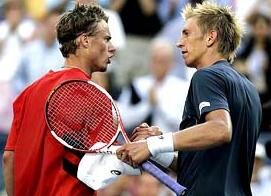 The third-seeded Australian, who won the Open in 2001, advanced with a 2-6, 6-1, 3-6, 6-3, 6-1 victory over the unseeded Jarkko Nieminen, the first player from Finland to reach a Grand Slam quarterfinal. Hewitt made only two unforced errors in the fifth set while putting away 15 winners to end the threat from the left-handed Nieminen. In the 1st set, Hewitt racked up 16 unforced errors. “I was struggling a little bit with my movement,” Hewitt said. “Just felt a step slower, a bit sluggish out there.” Hewitt seemed flat much of the match, never even trying to rally hstrongemimself with his usual cries of “Come on!” after a winner in the first four sets. Instead Nieminen generated noise from the crowd, inspiring chants of “Let’s go, Jarkko!” from fans pulling for an upset by the underdog. “I felt that he’s not that confident on the court because he doesn’t show those emotions that he’s usually showing,” said Nieminen, who had won only one match in three previous years at the Open. “Maybe he was a little bit surprised after the first set.” An Open semifinalist for the fifth time on a hard court similar to the kind he grew up on in Adelaide, Hewitt had come off an easy straight-sets victory against No. 15 Dominik Hrbaty in the fourth round. But Hewitt struggled before winning a five-setter against No. 25 Taylor Dent in the third round. Nieminen raced relentlessly in the opening set, winning the last five games as he retrieved shots that seemed out of reach. Hewitt settled into a rhythm in the 2nd set, winning 19 of 21 points on his way to a 5:0 lead. He served out the set to even the match 1-1, but then faded again. After they exchanged the next two sets, Hewitt finally got out of his funk. He broke Nieminen with a crisp forehand pass and let loose a “Come on!” that now really meant something. Hewitt served a 122-mph ace the first of 10 straight points he won on serve and raced to a 4:0 lead in the 5th set. Nieminen made one last stand, enduring nine deuces before holding serve. But Hewitt streaked through the next two games, closing out the match with a volley winner and yelling “Come on!” one last time.
The third-seeded Australian, who won the Open in 2001, advanced with a 2-6, 6-1, 3-6, 6-3, 6-1 victory over the unseeded Jarkko Nieminen, the first player from Finland to reach a Grand Slam quarterfinal. Hewitt made only two unforced errors in the fifth set while putting away 15 winners to end the threat from the left-handed Nieminen. In the 1st set, Hewitt racked up 16 unforced errors. “I was struggling a little bit with my movement,” Hewitt said. “Just felt a step slower, a bit sluggish out there.” Hewitt seemed flat much of the match, never even trying to rally hstrongemimself with his usual cries of “Come on!” after a winner in the first four sets. Instead Nieminen generated noise from the crowd, inspiring chants of “Let’s go, Jarkko!” from fans pulling for an upset by the underdog. “I felt that he’s not that confident on the court because he doesn’t show those emotions that he’s usually showing,” said Nieminen, who had won only one match in three previous years at the Open. “Maybe he was a little bit surprised after the first set.” An Open semifinalist for the fifth time on a hard court similar to the kind he grew up on in Adelaide, Hewitt had come off an easy straight-sets victory against No. 15 Dominik Hrbaty in the fourth round. But Hewitt struggled before winning a five-setter against No. 25 Taylor Dent in the third round. Nieminen raced relentlessly in the opening set, winning the last five games as he retrieved shots that seemed out of reach. Hewitt settled into a rhythm in the 2nd set, winning 19 of 21 points on his way to a 5:0 lead. He served out the set to even the match 1-1, but then faded again. After they exchanged the next two sets, Hewitt finally got out of his funk. He broke Nieminen with a crisp forehand pass and let loose a “Come on!” that now really meant something. Hewitt served a 122-mph ace the first of 10 straight points he won on serve and raced to a 4:0 lead in the 5th set. Nieminen made one last stand, enduring nine deuces before holding serve. But Hewitt streaked through the next two games, closing out the match with a volley winner and yelling “Come on!” one last time.
Semifinals: Greg Garber
Robby Ginepri is more than 12 years younger than Andre Agassi. He is faster and his serve is bigger, too. But no one does big moments better than Agassi. In the handful or so in a match, Agassi almost invariably seems to rises to the critical occasion. On Saturday, he found himself in a strange place. In 20 years as a professional Agassi has never, ever played three consecutive five-set matches. And yet, there he was at the age of 35 battling Ginepri in a roaring, soaring Arthur Ashe Stadium. Naturally, Agassi found a way. He secured the critical break, throwing down a ludicrous drop shot, and later won the match with a resounding 120-mile-an-hour ace. Agassi survived the semifinal match 6-4, 5-7, 6-3, 4-6, 6-3 in 2 hours 44 minutes. For Agassi, tennis is strictly a rational game. It is about geometry, angles and vectors, and the laws of probability. Typically, Agassi does the math and by the fifth or sixth point, he’s hitting a forehand winner into an open court. Ever the technician, Agassi ran Ginepri from side to side, and by the 5th set Ginepri seemed, understandably, tired. Patience is emerging as a new facet of his game, but there were times in long rallies when he snapped off an impatient shot, usually a forehand, in an attempt to end the point one way or another. Agassi saved three break points in his very first service game, then predictably broke Ginepri at 4-all. After squandering two set points, he won the third when Ginepri blasted an overhead past the end line. Agassi is 65-2 when he wins the first set in a Grand Slam, a 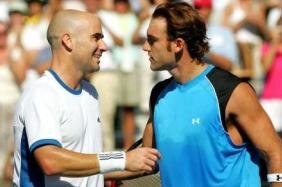 statistic that held up – barely. The 2nd set, in a modest surprise, went to Ginepri. The highlight was Agassi’s saving of seven break points in a single game. It didn’t matter, though, because Ginepri broke Agassi at 5:6 and the match had been leveled. The pattern continued, as Agassi won the 3rd set and Ginepri countered with the 4th. As impressive as Ginepri was, you never got the idea that Agassi had lost control. He broke Ginepri at 3:2 in the 5th set with that deadly dropshot, then cranked up his serve and went out in style. Ginepri became the fourth man in the Open era to play four consecutive five-setters in a major. Can Agassi possibly beat Roger Federer, who has beaten him seven straight times? “Most people have weaknesses,” Agassi said. “Federer doesn’t have weaknesses. So that equates to a problem. I mean, I could lie, I could say something else, but he’s earned that respect.” Federer saw off Lleyton Hewitt in four hard-fought sets to secure a second straight US Open final. The top seed was pushed hard but came through 6-3, 7-6(0), 4-6, 6-3 for his ninth successive win over Hewitt. A single break was enough to give the defending champion the 1st set but he had to save five set points in a desperately tight 2nd. Federer then dropped the 3rd before raising his game to break in game six of the 4th and serve out the match. With a run of eight straight wins over Hewitt going into the match, a routine win looked likely when Federer rolled through the first set and broke at the start of the second. But the world number one has been giving his opponents chances in recent matches and did so again as Hewitt broke straight back. The pattern was repeated in games seven and eight before Federer missed another chance to break in game nine. Hewitt sensed his opponent was not at his most ruthless and had the chance to level with five set points in the 10th and 12th games, but he could not convert and paid the price. Federer won the subsequent tie-break 7/0 to leave the Australian with a mountain to climb. As ever, Hewitt looked up for the challenge, saving two break points in game four of the third before edging ahead himself in game seven and taking the set. At last Hewitt seemed ready to take his nemesis to the brink and really test him, but he could not keep up the pressure. Federer stayed in touch early in the fourth set, narrowly failing to break in game two, and then did so in game seven as Hewitt handed him two double faults. After failing to build on earlier leads there was another scare for Federer at 0/30 down when serving for the match, but the top seed recovered to book his place in the final. “It wasn’t my best serving but you cannot expect to hit aces and service winners all the time,” said Federer afterwards. “Today I definitely had to survive more tough moments than in the past against him. I wish I could have played more consistent throughout the match but today it was tough.” Hewitt said: “I felt like I could go toe to toe with him. At least I had a little tussle with him. He’s definitely been the standout player. He’s lost three matches all year and on two of them he’s had match point.” Hewitt referred to Federer’s defeats to Safin (1 m.p. in Melbourne) & Gasquet (3 m.p. in Monte Carlo). In 2005 Federer lost also to Nadal in Paris, and Nalbandian in the Masters final. Federer’s 2005 is the best Open era year along with McEnroe’s 1984 in terms of ratio of win/loss record.
statistic that held up – barely. The 2nd set, in a modest surprise, went to Ginepri. The highlight was Agassi’s saving of seven break points in a single game. It didn’t matter, though, because Ginepri broke Agassi at 5:6 and the match had been leveled. The pattern continued, as Agassi won the 3rd set and Ginepri countered with the 4th. As impressive as Ginepri was, you never got the idea that Agassi had lost control. He broke Ginepri at 3:2 in the 5th set with that deadly dropshot, then cranked up his serve and went out in style. Ginepri became the fourth man in the Open era to play four consecutive five-setters in a major. Can Agassi possibly beat Roger Federer, who has beaten him seven straight times? “Most people have weaknesses,” Agassi said. “Federer doesn’t have weaknesses. So that equates to a problem. I mean, I could lie, I could say something else, but he’s earned that respect.” Federer saw off Lleyton Hewitt in four hard-fought sets to secure a second straight US Open final. The top seed was pushed hard but came through 6-3, 7-6(0), 4-6, 6-3 for his ninth successive win over Hewitt. A single break was enough to give the defending champion the 1st set but he had to save five set points in a desperately tight 2nd. Federer then dropped the 3rd before raising his game to break in game six of the 4th and serve out the match. With a run of eight straight wins over Hewitt going into the match, a routine win looked likely when Federer rolled through the first set and broke at the start of the second. But the world number one has been giving his opponents chances in recent matches and did so again as Hewitt broke straight back. The pattern was repeated in games seven and eight before Federer missed another chance to break in game nine. Hewitt sensed his opponent was not at his most ruthless and had the chance to level with five set points in the 10th and 12th games, but he could not convert and paid the price. Federer won the subsequent tie-break 7/0 to leave the Australian with a mountain to climb. As ever, Hewitt looked up for the challenge, saving two break points in game four of the third before edging ahead himself in game seven and taking the set. At last Hewitt seemed ready to take his nemesis to the brink and really test him, but he could not keep up the pressure. Federer stayed in touch early in the fourth set, narrowly failing to break in game two, and then did so in game seven as Hewitt handed him two double faults. After failing to build on earlier leads there was another scare for Federer at 0/30 down when serving for the match, but the top seed recovered to book his place in the final. “It wasn’t my best serving but you cannot expect to hit aces and service winners all the time,” said Federer afterwards. “Today I definitely had to survive more tough moments than in the past against him. I wish I could have played more consistent throughout the match but today it was tough.” Hewitt said: “I felt like I could go toe to toe with him. At least I had a little tussle with him. He’s definitely been the standout player. He’s lost three matches all year and on two of them he’s had match point.” Hewitt referred to Federer’s defeats to Safin (1 m.p. in Melbourne) & Gasquet (3 m.p. in Monte Carlo). In 2005 Federer lost also to Nadal in Paris, and Nalbandian in the Masters final. Federer’s 2005 is the best Open era year along with McEnroe’s 1984 in terms of ratio of win/loss record.
Final: Robert Deutsch
Roger Federer, a man of panache and unparalleled perfection in finals, withstood Andre Agassi‘s spirited upset bid to capture a second straight U.S. Open and sixth Grand Slam title. The Swiss player responded to his few moments of pressure by reeling off seven straight points in the tie-break that 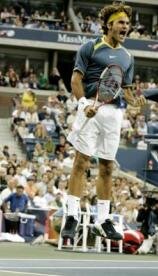 turned around the match, then blew Agassi away in the 4th set to win 6-3, 2-6, 7-6(1), 6-1 Sunday and run his stunning record in finals over the past two years to 23-0. “This is probably the most special Grand Slam final in my career,” Federer said. “To play against Andre in New York, it’s a dream.” Federer moved into a tie with Stefan Edberg and Boris Becker for Grand Slam titles among Open era players, and one behind John McEnroe and Mats Wilander. Pete Sampras holds the record with 14 Grand Slam titles, but at 24 years old Federer could well have a shot at that. Federer shrieked and leapt in the air when Agassi’s backhand return looped long on the championship point. The two men, who have the highest of respect for each other, shook hands warmly at the net. “It’s been a tough road, but it’s been a great road,” Agassi told the cheering crowd. “Roger played way too good today. Congratulations Roger, well done.” Though the 35-year-old Agassi was the oldest U.S. Open men’s finalist in 31 years, age had less to do with the difference in this match than Federer’s sheer strength, variety of serves, and superior balance of attacks from the baseline and the net that wore down Agassi. The Swiss forced the action, going for winners more aggressively, dancing around the court with poise, unrattled even when Agassi had him down a break at 4:2* (30/0) in the 3rd set. For a while there, Agassi seemed to be on the verge of pulling one of the great upsets in sports history – on the order of Muhammad Ali’s shockers over Sonny Liston and George Foreman. An 8-1 underdog, Agassi was just a few months removed from a career-threatening back injury that shot crippling pain down his right leg, led to his loss in the first round of the French Open and caused him to skip Wimbledon. He was playing a man who doesn’t lose in finals, who is at the peak of his game and health, and who is coming off his third straight Wimbledon championship. If this was Agassi’s last U.S. Open after 20 straight he won’t decide until the end of the year whether to retire – it was remarkable even in defeat. “This certainly isn’t easy to do at any age, especially 35,” Agassi said. “It’s been a privilege to compete against so many great champions over the last couple of decades or so. Without exception, Roger has been one of most enjoyable to compete against. Thank you New York for
turned around the match, then blew Agassi away in the 4th set to win 6-3, 2-6, 7-6(1), 6-1 Sunday and run his stunning record in finals over the past two years to 23-0. “This is probably the most special Grand Slam final in my career,” Federer said. “To play against Andre in New York, it’s a dream.” Federer moved into a tie with Stefan Edberg and Boris Becker for Grand Slam titles among Open era players, and one behind John McEnroe and Mats Wilander. Pete Sampras holds the record with 14 Grand Slam titles, but at 24 years old Federer could well have a shot at that. Federer shrieked and leapt in the air when Agassi’s backhand return looped long on the championship point. The two men, who have the highest of respect for each other, shook hands warmly at the net. “It’s been a tough road, but it’s been a great road,” Agassi told the cheering crowd. “Roger played way too good today. Congratulations Roger, well done.” Though the 35-year-old Agassi was the oldest U.S. Open men’s finalist in 31 years, age had less to do with the difference in this match than Federer’s sheer strength, variety of serves, and superior balance of attacks from the baseline and the net that wore down Agassi. The Swiss forced the action, going for winners more aggressively, dancing around the court with poise, unrattled even when Agassi had him down a break at 4:2* (30/0) in the 3rd set. For a while there, Agassi seemed to be on the verge of pulling one of the great upsets in sports history – on the order of Muhammad Ali’s shockers over Sonny Liston and George Foreman. An 8-1 underdog, Agassi was just a few months removed from a career-threatening back injury that shot crippling pain down his right leg, led to his loss in the first round of the French Open and caused him to skip Wimbledon. He was playing a man who doesn’t lose in finals, who is at the peak of his game and health, and who is coming off his third straight Wimbledon championship. If this was Agassi’s last U.S. Open after 20 straight he won’t decide until the end of the year whether to retire – it was remarkable even in defeat. “This certainly isn’t easy to do at any age, especially 35,” Agassi said. “It’s been a privilege to compete against so many great champions over the last couple of decades or so. Without exception, Roger has been one of most enjoyable to compete against. Thank you New York for 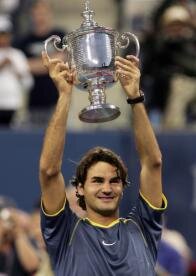 the last 20 years. It’s been a great ride.” Federer became the first man in the Open era, which started in 1968, to win Wimbledon and the U.S. Open back-to-back for the second consecutive year. Three players have done it twice, though not in consecutive years: Jimmy Connors, McEnroe and Sampras. The last player to accomplish the feat was Don Budge in 1937-38. Federer beat Agassi for the eighth straight time over the past two years after losing their first three meetings. Three of Federer’s victory in that streak have come at Grand Slam events, including the quarterfinals of the U.S. Open last year and the Australian Open this year. “I had to play my best match of the tournament,” Federer said. “It happened I played my best in the finals, as usual. I don’t know how I do it, but it definitely feels great every single time.” Federer drew first blood when he broke Agassi for a 4:2 lead in the 1st set, but putting that set away wasn’t easy. Agassi fended off three set points in his next service at 5:2, and won it with an ace. Federer needed five more set points when he served before he nailed down the set with a 123 mph service winner. “He plays the game in a very special way that I haven’t seen before,” said Agassi, who played so many memorable matches against Sampras and other champions. “I think he’s the best I’ve played against. He’s the only guy I’ve ever played against you hold serve to go 1:0 and you think all right, good. And I’m not just making fun of it. There’s a sense of urgency on every point, on every shot. It’s an incredible challenge. I certainly didn’t have enough today.” Rather than shrink away, Agassi briefly showed the stuff that helped him win eight major titles. He broke Federer for a 2:0 lead in the 2nd set, hammering a forehand return crosscourt that came back to Federer faster than his 111 mph serve. Agassi held serve the whole set, and raised hopes of an upset when he broke Federer again in the last game. This was a crafty, sharp Agassi, sometimes creeping in five or 10 feet inside the baseline to surprise Federer with short-hop returns, sometimes serving and volleying. Agassi lobbed for
the last 20 years. It’s been a great ride.” Federer became the first man in the Open era, which started in 1968, to win Wimbledon and the U.S. Open back-to-back for the second consecutive year. Three players have done it twice, though not in consecutive years: Jimmy Connors, McEnroe and Sampras. The last player to accomplish the feat was Don Budge in 1937-38. Federer beat Agassi for the eighth straight time over the past two years after losing their first three meetings. Three of Federer’s victory in that streak have come at Grand Slam events, including the quarterfinals of the U.S. Open last year and the Australian Open this year. “I had to play my best match of the tournament,” Federer said. “It happened I played my best in the finals, as usual. I don’t know how I do it, but it definitely feels great every single time.” Federer drew first blood when he broke Agassi for a 4:2 lead in the 1st set, but putting that set away wasn’t easy. Agassi fended off three set points in his next service at 5:2, and won it with an ace. Federer needed five more set points when he served before he nailed down the set with a 123 mph service winner. “He plays the game in a very special way that I haven’t seen before,” said Agassi, who played so many memorable matches against Sampras and other champions. “I think he’s the best I’ve played against. He’s the only guy I’ve ever played against you hold serve to go 1:0 and you think all right, good. And I’m not just making fun of it. There’s a sense of urgency on every point, on every shot. It’s an incredible challenge. I certainly didn’t have enough today.” Rather than shrink away, Agassi briefly showed the stuff that helped him win eight major titles. He broke Federer for a 2:0 lead in the 2nd set, hammering a forehand return crosscourt that came back to Federer faster than his 111 mph serve. Agassi held serve the whole set, and raised hopes of an upset when he broke Federer again in the last game. This was a crafty, sharp Agassi, sometimes creeping in five or 10 feet inside the baseline to surprise Federer with short-hop returns, sometimes serving and volleying. Agassi lobbed for  some points, won others with drops. The crowd had been on Agassi’s side from the start, greeting him with chants of “Let’s go Andre” and chanting his name. But Federer asserted himself again, and after one exchange of breaks midway through the third set, the Swiss bulled his way through the tie-break. Agassi was well aware of Federer’s record in finals – and mightily impressed by it. “That stat alone is pretty crazy,” Agassi said. “You’re talking about the best that are left in the tournament and he’s winning that many times in a row.” Losing the tie-break the way he did and getting run over in the fourth set was enough to demoralize Agassi and make him think back about his trip to get this far – possibly ending his Grand Slam journey in New York, a city he hated when he first came as a young man with big hair, a big game and a different attitude: “They can’t ever take away from what I’m leaving here with and that’s the memory of thousands of people pulling for me and showing appreciation for something I care dearly about.” Going out with a loss would hurt, he said, but he put it in perspective: “The first thing you have to assess is why did you lose. I just lost to a guy that’s better. There’s only so long you can deny it. He’s the best I’ve ever played against.” Federer earned the $1.1 million top prize and distanced himself further from the rest of men’s tennis world in the ATP Tour rankings. Agassi picked up $775,000, including $225,000 as the runner-up in the U.S. Open Series. Federer won his 10th tournament this year and 32nd title overall – 20 on hard courts. He ran his 2005 record to 45-1 on hard courts and 71-3 overall, the most dominant year by a man since John McEnroe went 82-3 in 1984. Federer’s 35th straight hard court victory also broke Sampras’ mark, set twice, of 34 straight. Stats of the final
some points, won others with drops. The crowd had been on Agassi’s side from the start, greeting him with chants of “Let’s go Andre” and chanting his name. But Federer asserted himself again, and after one exchange of breaks midway through the third set, the Swiss bulled his way through the tie-break. Agassi was well aware of Federer’s record in finals – and mightily impressed by it. “That stat alone is pretty crazy,” Agassi said. “You’re talking about the best that are left in the tournament and he’s winning that many times in a row.” Losing the tie-break the way he did and getting run over in the fourth set was enough to demoralize Agassi and make him think back about his trip to get this far – possibly ending his Grand Slam journey in New York, a city he hated when he first came as a young man with big hair, a big game and a different attitude: “They can’t ever take away from what I’m leaving here with and that’s the memory of thousands of people pulling for me and showing appreciation for something I care dearly about.” Going out with a loss would hurt, he said, but he put it in perspective: “The first thing you have to assess is why did you lose. I just lost to a guy that’s better. There’s only so long you can deny it. He’s the best I’ve ever played against.” Federer earned the $1.1 million top prize and distanced himself further from the rest of men’s tennis world in the ATP Tour rankings. Agassi picked up $775,000, including $225,000 as the runner-up in the U.S. Open Series. Federer won his 10th tournament this year and 32nd title overall – 20 on hard courts. He ran his 2005 record to 45-1 on hard courts and 71-3 overall, the most dominant year by a man since John McEnroe went 82-3 in 1984. Federer’s 35th straight hard court victory also broke Sampras’ mark, set twice, of 34 straight. Stats of the final








































YT films:
2004
Roddick vs. Nadal (highlights)
Henman vs. Kiefer
J.Johansson vs. Roddick
Federer vs. Agassi
Hewitt vs. J.Johansson
Federer vs. Hewitt
2005
Djokovic vs. Monfils (2 min)
Djokovic vs. Ancic (2 min)
Federer vs. Santoro
Agassi vs. Blake
Federer vs. Agassi
If we count one 1-0 RET set it’s 24-set winning streak
btw, Voo, do you have the list (not too long, at least 3-5 names) about longest sets winning and losing streak?
I haven’t got such a list but suppose that Connors had the longest streak – 44 sets in 1974
Great, thanks, how about the top of the losing streak?